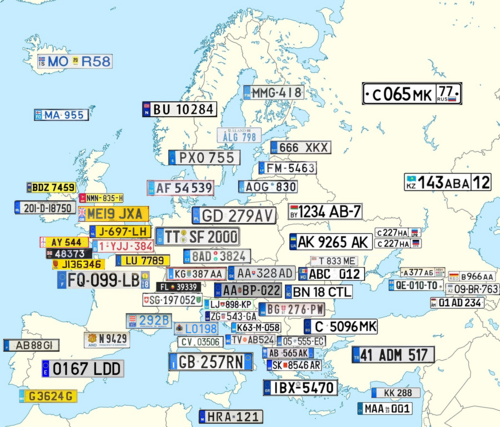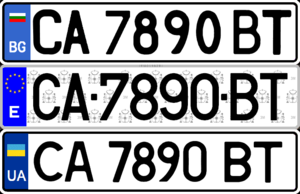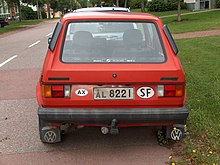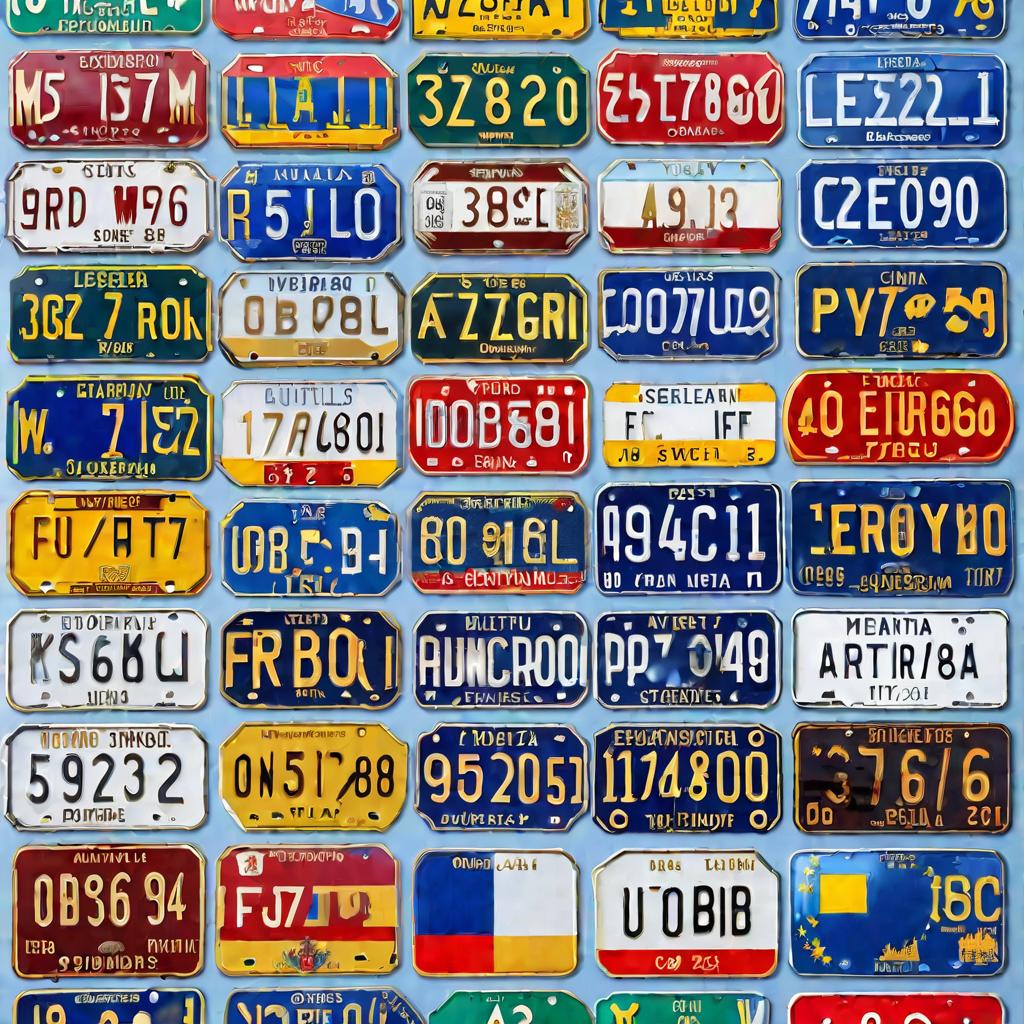From Wikipedia, the free encyclopedia
All EU countries issue registration plates in the common EU format. (F denotes France)
Some countries issue registration plates with a national flag or symbol. (N denotes Norway).
Some countries issue registration plates with no flag or symbol. (SRB denotes Serbia).
Some countries issue registration plates with a different background colour to the common blue colour. (IS denotes Iceland).
All of these registration plates satisfy the requirements for vehicles in cross-border traffic set in the Vienna Convention on Road Traffic as they display the international vehicle registration code for the country of registration incorporated into the vehicle registration plate.
A vehicle registration plate, also known as a number plate (British English), license plate or licence plate (American English and Canadian English respectively), is a metal or plastic plate or plates attached to a motor vehicle or trailer for official identification purposes. The registration identifier is a numeric or alphanumeric code that uniquely identifies the vehicle within the issuing authority’s database. In Europe most countries have adopted a format for registration plates that satisfies the requirements in the Vienna Convention on Road Traffic, which states that cross-border vehicles must display a distinguishing code for the country of registration on the rear of the vehicle. This sign may be an oval sticker placed separately from the registration plate, or may be incorporated into the plate. When the distinguishing sign is incorporated into the registration plate, it must also appear on the front plate of the vehicle, and may be supplemented with the flag or emblem of the national state, or the emblem of the regional economic integration organisation to which the country belongs.[1] An example of such format is the common EU format, with the EU flag above the country code issued in EU member states.
Format[edit]
The vast majority of European countries issue registration plates that are:
- 520 by 110 mm (20.5 by 4.3 inches)
- 520 by 120 mm (20.5 by 4.7 inches)
This is one of the basic standard sizes worldwide.
The others are:
- 305 by 152 mm (12.0 by 6.0 inches)
- 305 by 160 mm (12.0 by 6.3 inches)
- 372 by 135 mm (14.6 by 5.3 inches)
Some European countries use registration plates in other formats:
- 330 by 140 mm (13.0 by 5.5 inches) in Andorra
- 440 by 120 mm (17.3 by 4.7 inches) in Finland
- 260 by 110 mm (10.2 by 4.3 inches) in Monaco
- 390 by 120 mm (15.4 by 4.7 inches) in San Marino
- 300 by 80 mm (11.8 by 3.1 inches) in Switzerland and Liechtenstein (only front plates)
- 360 by 110 mm (14.1 by 4.3 inches) in Italy (only front plates)
- 390 by 130 mm (15.4 by 5.1 inches) and 345 by 130 mm (13.5 by 5.1 inches) in Åland
European Union[edit]
The common EU format of having a blue section on the extreme left with EU circle of stars and the country code was introduced by Council Regulation (EC) No 2411/98 of 3 November 1998[2] and entered into force on 11 November 1998. It was based on a model registration plate which three member states had already introduced: Ireland (1991),[3] Portugal (1992)[4] and Germany (1994).[5] Luxembourg plates had displayed the EU flag on the left since 1988. Vehicles with registration plates in the EU format do not need to display the white oval international vehicle registration code while within the European Economic Area,[6] or in countries party to the Vienna Convention on Road Traffic (except if the plate is issued in Cyprus, Ireland, Malta and Spain).[7]
- The common design consists of a blue strip on the left side of the plate. This blue strip has the EU flag symbol (twelve yellow stars), along with the country code of the member state in which the vehicle is registered. All EU countries now issue plates in the common format, but the use of the EU flag on registration plates is optional for member states.
- EU member states that require foreign vehicles to display a distinguishing sign of the country of origin are obliged by Article 3 of EC 2411/98 to accept the standard design as a distinguishing sign when displayed on a vehicle registered in another member state. The requirement to display a distinguishing sign stems from the Vienna Convention on Road Traffic, and the regulation is referencing the recognition of distinguishing signs according to that convention.[2]
- EU format plates are either white or yellow, on a plate wider than it is tall. Yellow registration plates are used both front and rear in Luxembourg and the Netherlands. Denmark and Hungary use yellow plates for vehicles registered as commercial vehicles. Denmark implemented the EU format on a voluntary basis in 2009.[8] Danish plates have a small holographic strip to the right of the blue EU strip. In Greece, Cyprus, Latvia and Sweden yellow plates are used for taxi vehicles. In Poland yellow plates are used for historic vehicles.
- Belgium uses red characters and is the only country not to use the standard black-on-white or black-on-yellow combination; with the introduction of European-style plates in November 2010, a slightly darker shade of red was chosen (RAL 3003) to improve legibility.
- Most European countries use metal plates, however France and Ireland use a mixture of flat plastic and metal plates. Flat plastic plates have earlier also been used in Sweden.
Other countries[edit]
Several non-EU European states have implemented formats similar to the EU format, with national flags or symbols in place of the circle of stars. Vehicles with such registration plates, issued in countries party to the Vienna Convention on Road Traffic, do not need to display the white oval international vehicle registration code while within countries signatory to the Vienna Convention on Road Traffic.[7]
- Norway is an example of such a state, issuing registration plates with the Norwegian flag replacing the circle of stars and the country code N. In Norway, regular plates are white with black characters, however, cars with front seats only (used for carrying goods) have green plates with black characters. Norwegian registration plates are made of metal, but flat plastic plates has also been used earlier.
- Iceland issues registration plates similar to Norway with the Icelandic flag and the country code IS, however on a white background.
- Ukraine issues plates similar to the Norwegian ones, with the Ukrainian flag above the country code UA.
- Moldovan registration plates have a wider than usual blue band with the Moldovan flag and the international country code MD.
- Albanian registration plates have a double-headed eagle above the country code AL.
- Bosnia and Herzegovina issues plates with a blue strip on the left side of the plate with the country code BIH, but without the EU stars or any other symbol. So does Turkey (TR) (which is in a customs union with the EU), Montenegro (MNE), North Macedonia (NMK) and Serbia (SRB).
- Belarus issues registration plates with the national flag above the country code on the left side, but without the blue strip. Iceland issues plates similar to the Belarusian plates, with the Icelandic flag above the country code IS on the left side. Iceland, however, is not party to the Vienna Convention on Road Traffic.
- Andorra and Monaco use registration plates with their coat of arms above the respective country codes (AND and MC). San Marino issues similar plates but with the text «Repubblica di San Marino» underneath the coat of arms, instead of the country code RSM.
- Of those states that joined in the 2004 enlargement of the European Union Malta already used EU format plates, while Latvia, Poland and Lithuania had used plates displaying the national flag before their accession, as did Bulgaria and Romania before their accession in 2007.
- United Kingdom: yellow plates at the rear and white at the front and can be flat plastic or metal. Since 2021, the European symbol of a circle of stars must not be displayed with any of the following identifying letters (due to Brexit). Only registration plates with the distinguishing code «UK» (coloured black or blue) on its own, or together with the Union Flag (orientated in landscape) are valid in other countries party to the Vienna Convention on Road Traffic.[9]
- England, Scotland and Wales: owners here may choose to display plates with the national flag of England, Scotland or Wales, or the Union Flag and the code names «ENG», «Eng», «ENGLAND» or «England» for the English flag, «SCO», «Sco», «SCOTLAND» or «Scotland» for the Scottish flag, «CYM», «Cym», «CYMRU», «Cymru», «WALES» or «Wales» for the Welsh flag, «GB», «GREAT BRITAIN», «Great Britain», «UK», «UNITED KINGDOM» or «United Kingdom» for the Union Flag respectively.[10] With such an arrangement, a «UK» sticker must also be affixed at the rear of the vehicle when driving abroad.[11]
- Northern Ireland: motorists with vehicles registered here are not permitted to display the letters NI alongside any flag; only the Union Flag alongside the «UK» code being optionally permitted.[12]
- Until 28 September 2021, the United Kingdom used «GB» as the identifying letters. This was changed after the British government notified the United Nations «that the United Kingdom is changing the distinguishing sign that it had previously selected for display in international traffic on vehicles registered in the United Kingdom, from ‘GB’ to ‘UK‘«.[13]
- Gibraltar uses plates similar to the EU format, but without a flag or symbol, only the code GBZ. As in the UK, yellow plates at the rear and white at the front.
- The Crown dependencies of Guernsey, including Alderney and Jersey and the Isle of Man have registration plates that are different from those used in the UK. Guernsey plates sometimes contain the letters GBG below the Guernsey flag on the left side, Alderney plates may have GBA below an Alderney flag. Jersey registration plates may incorporate the coat of arms of Jersey in a white strip on the left, along with the country identifier GBJ, and since 2004 Manx plates may incorporate the Manx flag and the international country identification code GBM.
Common letter and digit systems between countries[edit]
Several countries have made efforts to avoid duplicating registration numbers used by other countries. This is not completely successful and there are occasional difficulties in connection with parking fines and automatic speed cameras.
- Belgium (until 2010), Cyprus (from 90s), Finland, Georgia (until 2014), Hungary (1990-2022), Lithuania, Malta, Sweden (1974-2019), and Moldova (since 2014) each use combinations of first three letters and then three digits.[14]
- Bulgaria uses plate numbers in the form A[A]-0000-AA, i.e. one or two letters representing the region, then four digits, then two more letters. All letters used are intersection of Latin and Cyrillic alphabet, i.e. A, B, C, E, H, K, M, O, P, T, X and Y. The same format is in use in Ukraine since 90s, N.Macedonia and Spain until 2000 (but still valid, called «sistema provincial»).
- Greece uses a combination of three letters (before only two) (which are chosen from the 14 character shapes which appear in both the Latin and the Greek alphabet (but not necessarily with the same sound values), i.e. A, B, E, Z, H, I, K, M, N, O, P, T, Y, X in Greek alphabetic order) and four numbers, in the form of AAA-0000, while Spain uses a four number-three letter combination, in the form of 0000 BBB (vowels and some maybe confusing consonants, like Ñ and Q, are not used)
- Denmark and Norway use two letters and five digits (
AB 12345), while trailers use two letters and four digits. The plates look very similar, but Denmark has a red border around the plate. Use of the country code on the plate may mitigate this problem (Norway began using the system on 1 November 2006). Denmark has begun running out of combinations in this style and has now introduced combinations previously reserved for the Faroe Islands for EU style registration plates (which will use different letters from non-EU style plates). - The Netherlands (until 2008) and Portugal both use three groups of two characters (letters or numbers) in several sequences:
AB-12-CD,12-34-AB,12-AB-34,AB-12-34, etc. However, Portuguese plates since 90s have a white background, while those of Netherlands (after 1 January 1978) have a yellow one, though both countries also use white letters on blue plates for classic cars. Furthermore, newer plates on Dutch vehicles only contain consonants, to avoid coincidental abbreviations or words. Also some sensitive letter combinations, such as SS or SD, are not used. The combination ‘AA’ is reserved for cars of the royal family. Dutch company registered bus, truck and/or minivan plates always start with aBor aV. Dutch taxis use blue registration plates. The number of new combinations ran out in 2008. New registered cars in the Netherlands now use the format of two digits-three letters-one digit (12-ABC-3). - Belgium used the sequence
ABC-123between 1973 and 2008. When these combinations ran out in 2008, the inverse sequence123-ABCwas adopted, with the first plate in the new series issued on 25 June 2008. With the introduction of the EU format registration plates on 15 November 2010, a seven-character combination1-ABC-234is used and the previous123-ABCwas discontinued. However, the six-character plates will remain valid, and no date is set for their expiration. Since Belgian plates are linked to an owner rather than to a vehicle, these older plates are likely to remain in use for a considerable time. As a way to phase out the six-character plates, future vehicle subscriptions will only be possible on the seven-character plates. Private numbers, not following any notation, are also allowed. - Luxembourg standard registration plates use two letters and four digits (
AB 1234). Plates with 5 digits (12345) and 4 digits (1234) are also issued upon request. Older series with two letters and three digits (AB 123), and one letter and 4 digits (A 1234) are no longer issued but are still in use. Special plates for diplomats, the government, the grand-ducal family, military vehicles and temporary registrations exist and follow specific rules. Two letters and three digits (AB 123) is also used in Northern Cyprus, and until 1973 it was used on the entire island of Cyprus. - Current registrations allocated in Romania and the United Kingdom (where the registration contains two digits) are both of the form
AB 12 CDE. The Romanian rear plates are white whereas UK ones are yellow. There is also a difference in the spacing and the font. In 2010, Bucharest, the capital of Romania, adopted the formB 123 AAA, three digits and three letters, because the number of cars had risen. In the United Kingdom,B 123 AAAwas issued to cars registered from August 1984 to August 1985. Aside from this, some county codes can clash (MH, in Romania it stands for Mehedinți, and in the United Kingdom, it stands for Manchester). - Until 1973/74 the Swedish pattern was one letter representing the län (county) where the car was first registered, followed by four or five digits. However, in the more populated län, a second letter was introduced over time. For example, vehicles from southernmost county got the letter M + five digits, later also MA + five digits, MB + five digits etc. A problem was that the two northernmost counties had already been given two letters, the letter prefixes AC and BD, as the number of counties exceeded the number of usable letters. This system gave similar numbers as Denmark and Norway. The
ABC 123system was introduced gradually from July 1973 until June 1974. All vehicles had to switch plates, the old were not permitted after this. - Slovakia uses
MM 123ABand Croatia usesMM 123-A,MM 123-AB,MM 1234-AorMM 1234-AB(MM being the two-letter city code). Both countries use the national coat of arms after first two letters. Croatia uses only Croatian Latin letters without diacritics, except for city codes, like ČK for Čakovec. - Montenegro and Serbia, currently not members of the EU, used the following:
MM 12-34,MM 123-45orMM 123-456(MM being two letter abbreviation of municipality), and having state flag (of former Yugoslavia, later Serbia and Montenegro) between municipality and numbers. Montenegro left that system in 2007, and introduced new format:MM AB 123with Montenegrin coat of arms in circular shape between municipality and letter sequence. Blue strip with MNE country code is placed in the left side, with vacant place for EU stars, in case of joining the Union. Serbia also uses new system since 2011, with blue strip country code SRB:MM 123-ABandMM 1234-AB, with Serbian coat of arms between municipality and number sequence. The first two letters on the Serbian plates represent the municipality code, written in Latin letters, and repeated in Cyrillic characters with small letters under the coat of arms. The following system is used for taxi vehicles:BG 123 TXorBG 1234 TXand recently evenBG 12345 TX, where a TX combination is reserved for this purpose only (another taxi vehicles have private vehicle plates). Since 2017, Serbia stopped issuing plates with last two letters containing W, Q, Y, X (except TX), Č, Ć, Š, Ž, and Đ, however Serbian Latin letters with diacritics are still used to mark the municipality code, like ČA for Čačak or ŠA for Šabac. - Poland and the United Kingdom have both used
AAA 123A. In Poland these were issued from 1976 to 2000, in the UK, they were issued from 1963 to 1983, with those issued prior to 1973 being the same colour as their Polish counterparts (white on black). While in United Kingdom black plates are still valid, in Poland, black registration plates will lose its validity after 2023.[citation needed]
Differing numbering systems[edit]
Individual European countries use differing numbering schemes and text fonts:
- Most countries, including Austria, Bulgaria, Croatia, the Czech Republic, Germany, Greece, Ireland, Montenegro, North Macedonia, Norway, Poland, Romania, Serbia, Slovenia and Switzerland (formerly also Sweden until 1974, Italy until 1994, Bosnia and Herzegovina until 1998, Lithuania and Spain until 2000, Estonia until 2004, Albania until 2011 and Slovakia until 2023, also former countries East Germany until 1990, Soviet Union until 1991, Czechoslovakia until 1993, Yugoslavia until 1998 and Serbia and Montenegro until 2011), have systems in which there is a direct link between a letter or letters appearing on the plate and the town or district where the plate was issued (e.g. «B» and «M» in Germany for Berlin and Munich, «BG» and «KG» in Serbia for Belgrade and Kragujevac and «AX» and «KY» in Greece for Achaea and Corfu). Some countries, including Austria, Germany, Slovenia, and Switzerland, even include a regional or municipal coat of arms on the plate, but Croatia, Montenegro and Serbia include a national coat of arms. In Ireland, all registration plates have the name of the county of registration in Irish in smaller letters on the top.
- France (until 2009), and Turkey and Russia (since October 2013) use a system with an indirect number relation to the car’s place of registration. Formerly in France, the last two characters on a plate comprised the departmental code of registration. This pattern was discontinued, but in response to popular outcry, France added a second colour bar, on the right edge of the plate, where the departmental code (no longer a part of the registration number) appears. The Turkish system has since (around early 2018) been overridden by most provinces giving out three letter-three number codes (99 XXX 000) in alphabetical order, regardless of province subdivisions.
- The United Kingdom uses a system based on the region where the car was first registered and the date of registration, for example CA52 GJK, where the «C» stands for Wales (the name of that country in Welsh being Cymru), the «A» stands for Cardiff (the letters A-O assigned to the city), and the «52» means that the car was registered in the period September 2002 to February 2003.
- Belgium, Bosnia and Herzegovina, Denmark, Iceland, Estonia (after 2004), Finland, Hungary, Latvia, Lithuania (after 2000), Luxembourg, the Netherlands, Portugal, Slovakia (after 2023) and Sweden (after 1974) use plates that do not denote the location where the car is registered. Since 2000 Spain no longer uses province codes on plates but codes like ‘B’ for Barcelona or ‘M’ for Madrid can still be seen, for cars registered before that date. Italy, also, did not use the province codes on plates between 1994 and 1999.
- Italy, since 1999, has added a blue strip on either side. On the right one are the two digits of the year when the plate was issued (e.g. «99», «05», «08») and below that there may be an optional two-letter code for the province, such as «MO» for the Province of Modena. Albania and France have adopted similar formats.
- Portuguese registration plates since late 1998 have a yellow strip on the right side, with one number at the top and another at the bottom separated by a line, respectively the year and month of the vehicle’s registration. This strip was discontinued for the new registration plates issued since March 2020.
- Irish registration plates also contain the year in which the vehicle was registered. A car registered in 2008 would have the format 08-XX-XXXX. In 2013, this was updated to specify which half of the year the registration occurred. So from January to June, the registration plate would show (for 2018) 181-XX-XXXX, whereas from July to December, the plate instead shows 182-XX-XXXX.
- Turkish registration plates consist of letters and digits in combinations of 99 AB 999, 99 A 9999, 99 ABC 99, 99 AB 9999 or 99 A 99999 where the first two digits show which province the vehicle is registered from. First two digits numbers go from 01 to 81 (as there are 81 provinces in Turkey) and each one is assigned to a province with alphabetical order e.g. 01 is the code of the province Adana or 34 is the code of the province Istanbul. All 81 provinces used to use «01 AB 123» style plates initially until all combinations ran out, then the province starts to use 01 A 1234 then 01 ABC 12 etc. As a result, three largest provinces i.e. Istanbul, Ankara and İzmir are currently issuing 99 ABC 999 style plates. 99 A 99999 series are not regular since they are only used in provinces where commercial vehicles are abundant e.g. Bursa to distinguish these vehicles there from passenger cars. Letters «I» and «O» are only used in the middle 01 ABC 12 series e.g. 34 YOC 34 or 06 TIL 56 to avoid confusion with numerals «1» and «0» respectively. As an exception to this rule, there is a «HO» series that is only granted to privately operated city buses (halk otobüsleri in Turkish). Also some letters combinations like «PKK» are not issued due to their referring to political organisations or words likely to cause offence.
Cross-border traffic[edit]
According to the Vienna Convention on Road Traffic, vehicles in cross-border traffic are obliged to display a distinguishing sign of the country of registration on the rear of the vehicle. This sign may either be placed separately from the registration plate or, after the convention was amended in 2006, may be incorporated into the vehicle registration plate. One of the main benefits of the convention for motorists is the obligation on signatory countries to recognise the legality of vehicles from other signatory countries. The following requirements must be met when driving outside the country of registration:
- The physical requirements for the separate sign are defined in Annex 3 of the Vienna Convention on Road Traffic, which states that the letters shall be in black on a white background having the shape of an ellipse with the major axis horizontal. The distinguishing sign should not be affixed in such a way that it could be confused with the registration number or impair its legibility.
- When the distinguishing sign is incorporated into the registration plate, it must also appear on the front registration plate of the vehicle, and may be supplemented with the flag or emblem of the national state, or the emblem of the regional economic integration organisation to which the country belongs. The distinguishing sign should be displayed on the far left or far right on the registration plate. When a symbol/flag/emblem is also displayed, the distinguishing sign shall obligatory be placed on the far left on the plate. The distinguishing sign shall be positioned so to be easy identifiable and so that it cannot be confused with the registration number or impair its legibility. The distinguishing sign shall therefore be at least a different colour from the registration number, or have a different background colour to that reserved for the registration number, or be clearly separated from the registration number, preferably with a line.[1]
The common EU format of having a blue section on the extreme left with EU circle of stars and the country code was introduced by Council Regulation (EC) No 2411/98 of 3 November 1998 and entered into force on 11 November 1998. According to Article 3 of the regulation shall member states that require vehicles registered in another member state to display a distinguishing registration sign also recognise distinguishing signs issued in accordance with the regulation (the common EU format).[2] After the amendment of the Vienna Convention on Road Traffic in 2006, registration plates issued in the common EU format also satisfies the requirements of the named convention and hence is also valid in all countries party to the Vienna Convention on Road Traffic (if the issuing country is party to the convention).
Mopeds are exempt, and do not need to wear a distinguishing sign. If their country does not require a license plate, then the vehicle can cross borders without a license plate as well. Example: Swedish moped class II or the German insurance plate, which isn’t a official license plate and only shows that insurance has been paid.
After Brexit the European Commission confirmed that British cars with registration plates with the distinguishing sign incorporated do not need a separate sign when driving in EU countries party to the Vienna Convention on Road Traffic. If the registration plate does not include the distinguishing sign, or if the vehicle is driven in an EU country not party to the Vienna Convention, a separate sign has to be displayed at the rear of the vehicle. All EU countries except Cyprus, Ireland, Malta and Spain are party to the convention.[15]
|
Registration plate in the common EU format issued in EU countries signatory to the Vienna Convention on Road Traffic
|
Registration plate in the common EU format issued in EU countries not signatory to the Vienna Convention on Road Traffic
|
Registration plates issued in European countries signatory to the Vienna Convention on Road Traffic
|
|
|---|---|---|---|
|
Member states of the European Economic Area (EEA)
|
Yes | Yes | No |
|
Countries signatory to the Vienna Convention on Road Traffic
|
Yes | No | Yes |
Some European countries are not party to the Vienna Convention on Road Traffic. Cyprus, Ireland, Malta and Spain are examples of non-signatory countries. Those who have not ratified the convention may be parties to the older 1949 Geneva Convention on Road Traffic, which is the case of the aforementioned countries. According to the Geneva convention, a distinguishing sign of the country of registration must be displayed on the rear of the vehicle. This sign must be placed separately from the registration plate and may not be incorporated into the vehicle registration plate. The letters shall be in black on a white background having the shape of an ellipse with the major axis horizontal.
List[edit]
Vehicle registration plates of each country are described in the following table:
Motorcycle plates are used for motorcycles and vehicles where mounting space is an issue, such as taxis which display their taxi licence plate beside the vehicle registration plate[clarify], and vehicles imported from countries where the mounting space was not originally designed to take European-sized plates (e.g. USA).
Moped plates are used for 2-wheeled moped and, in the European Union and EER countries for 4-wheeled mopeds (light quadricycle)
Countries[edit]
| Country | Code | Strip | Example | Motorcycle plates | Moped |
|---|---|---|---|---|---|
| AL |  |
||||
| AND |  |
 |
|||
| A | 
|
 
|
|||
| BY | 
|
||||
| B | 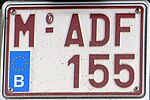
|
||||
| BIH | 
|
||||
| BG | 
|
||||
| HR |
|
||||
| CY | 
|
||||
| CZ | 
|
||||
| DK | 
|
||||
| EST |
|
||||
| FIN |  |
|
|||
| F | 
|
||||
| D | 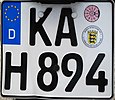
|

|
|||
| GR | 
|
 
|
|||
| H | 
|

|
|||
| IS | 
|

|
|||
| IRL | 
|
||||
| I | 
|

|
|||
| LV | 
|
||||
| FL | 
|

|
|||
| LT | 
|

|
|||
| L | 
|

|
|||
| M | 
|
||||
| MD |  |

|
|||
| MC |  |
 |

|
||
| MNE | 
|
||||
| NL |  |

|
|||
| NMK[fn 1] | 
|
||||
| N | 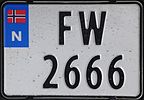
|
||||
| PL | 
|
||||
| P | 
|

|
|||
| RO | 
|
||||
| RSM | 
|
||||
| SRB | 
|

|
|||
| SK | 
|
||||
| SLO | 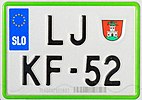
|
||||
| E | 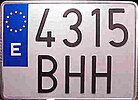
|

|
|||
| S |  |
||||
| CH | 
|

|
|||
| UA | 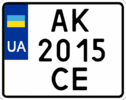
|
||||
| UK[fn 2] |
|

|
|||
| V[fn 3] |  |
- Notes
- ^ Prior to February 2019, North Macedonia used the distinguishing sign «MK».[16]
- ^ The national identifier is optional on British registration plates. Registration plates with the «UK» identifier displayed on its own or with a Union Jack flag satisfy the requirements from the Vienna Convention on Road Traffic, and are valid in countries party to the Convention.[9] The specification of plates incorporating the UK code was created by the British Number Plate Manufacturers Association, and is seen as the default design by the Department for Transport.[17]
Registration plates can also feature the national flag of England, Scotland or Wales together with their corresponding code or name (such as «ENG», «Eng» «ENGLAND» or «England»). These are valid within the UK,[18] but a «UK» sticker must be affixed at the rear of the vehicle if driven abroad.[11]
Until Brexit, UK registration plates could be issued in the common EU format. This format cannot be issued after the end of the transition period.[19] A «UK» sticker must be affixed at the rear of a vehicle with a registration plate displaying the EU emblem when driven abroad.[11] Note: Many cars also have EU flag on if issued pre-Brexit and cars can have EU flag only with the code «GB»; these plates are not valid for international use, a «UK» sticker must be affixed at the rear of the vehicle if driven abroad.[11]
- ^ CV (Italian: Città del Vaticano) is used as a prefix on the licence plate number itself for private vehicles. The prefix used on official and government vehicles is SCV (Italian: Status Civitatis Vaticanae)
Transcontinental countries[edit]
| Territory | Code | Strip | Example | Motorcycle plates |
|---|---|---|---|---|
| AM |  |

|
||
| AZ | 
|
|||
| GE | 
|
|||
| RUS | 
|
|||
| TR | 
|
Dependent territories[edit]
| Territory | Code | Strip | Example | Motorcycle plates |
|---|---|---|---|---|
( |
FIN[fn1 1] |  |

|
|
( |
GBA | 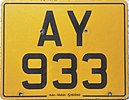
|
||
( |
FO |  |

|
|
( |
GBZ[a] |  |

|
|
( |
GBG | 
|
||
( |
GBM |  |

|
|
( |
GBJ | 
|
- Notes
- ^ The official distinguishing sign is FIN as in the rest of Finland, but the Parliament of Åland wants to introduce «AX» as its official code.
Disputed territories[edit]
| Territory | Code | Strip | Example | Motorcycle plates |
|---|---|---|---|---|
| ABH | ||||
| RKS | ||||
| TRNC | ||||
| RSO | 
|
|||
| PMR | 
|
Timeline[edit]
| Timeline of Vehicle registration plates of Europe from 1960 until today | ||||||||||||||||||||||||||||||||||||||||||||||||||||||||||||||||||||||
|---|---|---|---|---|---|---|---|---|---|---|---|---|---|---|---|---|---|---|---|---|---|---|---|---|---|---|---|---|---|---|---|---|---|---|---|---|---|---|---|---|---|---|---|---|---|---|---|---|---|---|---|---|---|---|---|---|---|---|---|---|---|---|---|---|---|---|---|---|---|---|
| Country | 1960s | 1970s | 1980s | 1990s | 2000s | 2010s | 2020s | |||||||||||||||||||||||||||||||||||||||||||||||||||||||||||||||
| 0 | 1 | 2 | 3 | 4 | 5 | 6 | 7 | 8 | 9 | 0 | 1 | 2 | 3 | 4 | 5 | 6 | 7 | 8 | 9 | 0 | 1 | 2 | 3 | 4 | 5 | 6 | 7 | 8 | 9 | 0 | 1 | 2 | 3 | 4 | 5 | 6 | 7 | 8 | 9 | 0 | 1 | 2 | 3 | 4 | 5 | 6 | 7 | 8 | 9 | 0 | 1 | 2 | 3 | 4 | 5 | 6 | 7 | 8 | 9 | 0 | 1 | 2 | 3 | 4 | 5 | 6 | 7 | 8 | 9 | |
|
AB 1234 |
AB 12345 |
12 AB 123 |
AB 1234 A |
|
|
|||||||||||||||||||||||||||||||||||||||||||||||||||||||||||||||||
|
|
|
|
|||||||||||||||||||||||||||||||||||||||||||||||||||||||||||||||||||
|
W 123.456 |
W |
|
||||||||||||||||||||||||||||||||||||||||||||||||||||||||||||||||||||
|
1234 AB |
1234 ABC |
|
||||||||||||||||||||||||||||||||||||||||||||||||||||||||||||||||||||
|
1234.A |
A.AB.12 |
ABC•123 |
ABC-123 |
123-ABC |
|
|||||||||||||||||||||||||||||||||||||||||||||||||||||||||||||||||
|
AB-12345 A |
AB |
123-A-123 |
|
|||||||||||||||||||||||||||||||||||||||||||||||||||||||||||||||||||
|
ТБ |
||||||||||||||||||||||||||||||||||||||||||||||||||||||||||||||||||||||
|
||||||||||||||||||||||||||||||||||||||||||||||||||||||||||||||||||||||
|
Пз•X•1234 |
ПЗ•1234•X |
PA 1234 AX |
|
|
||||||||||||||||||||||||||||||||||||||||||||||||||||||||||||||||||
|
AB |
|
|||||||||||||||||||||||||||||||||||||||||||||||||||||||||||||||||||||
|
AB 123 |
AB 123 |
ABC 123 |
|
|
||||||||||||||||||||||||||||||||||||||||||||||||||||||||||||||||||
|
ABC 12-12 |
1A2 12-12 |
|
||||||||||||||||||||||||||||||||||||||||||||||||||||||||||||||||||||
|
KA 12.123 |
AB 12 345 |
|||||||||||||||||||||||||||||||||||||||||||||||||||||||||||||||||||||
|
||||||||||||||||||||||||||||||||||||||||||||||||||||||||||||||||||||||
|
123 ABC |
|
|||||||||||||||||||||||||||||||||||||||||||||||||||||||||||||||||||||
|
ABC-12 |
ABC-123 |
|
||||||||||||||||||||||||||||||||||||||||||||||||||||||||||||||||||||
|
123 ABC 75 |
|
|
||||||||||||||||||||||||||||||||||||||||||||||||||||||||||||||||||||
|
FL — AB 1234 |
|
|||||||||||||||||||||||||||||||||||||||||||||||||||||||||||||||||||||
|
123•123 |
AB-1234 |
ABC-1234 |
|
|||||||||||||||||||||||||||||||||||||||||||||||||||||||||||||||||||
|
AB•12•12 |
|
|
|
|||||||||||||||||||||||||||||||||||||||||||||||||||||||||||||||||||
|
A12345 |
AB 123 |
|
|
|||||||||||||||||||||||||||||||||||||||||||||||||||||||||||||||||||
|
ABC 123 |
123 ABC |
87-AB-1234 |
|
|
|
|||||||||||||||||||||||||||||||||||||||||||||||||||||||||||||||||
|
MI 123456 |
MI MI 123456 |
MI 123456 |
AB 123AB |
|
||||||||||||||||||||||||||||||||||||||||||||||||||||||||||||||||||
|
|
|||||||||||||||||||||||||||||||||||||||||||||||||||||||||||||||||||||
|
FL |
||||||||||||||||||||||||||||||||||||||||||||||||||||||||||||||||||||||
|
|
|||||||||||||||||||||||||||||||||||||||||||||||||||||||||||||||||||||
|
12345 |
A 1234 |
AB 123 |
|
|
||||||||||||||||||||||||||||||||||||||||||||||||||||||||||||||||||
|
1234 |
A-1234 |
|
||||||||||||||||||||||||||||||||||||||||||||||||||||||||||||||||||||
|
|
|
|
|||||||||||||||||||||||||||||||||||||||||||||||||||||||||||||||||||
|
|
|
||||||||||||||||||||||||||||||||||||||||||||||||||||||||||||||||||||
|
||||||||||||||||||||||||||||||||||||||||||||||||||||||||||||||||||||||
|
AB-12-12 |
12-12-AB |
12-AB-12 |
AB-12-AB |
AB-AB-12 |
|
|
|
|||||||||||||||||||||||||||||||||||||||||||||||||||||||||||||||
| AB РМ123-AB | AB AБ 123-AB |
|
|
|||||||||||||||||||||||||||||||||||||||||||||||||||||||||||||||||||
|
A-12345 |
AB 12345 |
AB 12345 |
|
|||||||||||||||||||||||||||||||||||||||||||||||||||||||||||||||||||
|
AB 1234 |
ABC 1234 |
|
|
|||||||||||||||||||||||||||||||||||||||||||||||||||||||||||||||||||
|
AA-12-34 |
|
|
|
|
||||||||||||||||||||||||||||||||||||||||||||||||||||||||||||||||||
|
12,345-B |
12-B-12345 |
|
|
|||||||||||||||||||||||||||||||||||||||||||||||||||||||||||||||||||
|
12-34 МОЦ |
и 1234 ЦП |
|
||||||||||||||||||||||||||||||||||||||||||||||||||||||||||||||||||||
|
RSM |
RSM |
RSM |
|
|
||||||||||||||||||||||||||||||||||||||||||||||||||||||||||||||||||
|
BG |
BG |
|
||||||||||||||||||||||||||||||||||||||||||||||||||||||||||||||||||||
|
ABC 12-12 |
|
|
|
|||||||||||||||||||||||||||||||||||||||||||||||||||||||||||||||||||
|
LJ |
|
|
||||||||||||||||||||||||||||||||||||||||||||||||||||||||||||||||||||
|
AB-12345 |
AB-1234AB |
|
||||||||||||||||||||||||||||||||||||||||||||||||||||||||||||||||||||
|
A 12345 |
ABC 123 |
|
||||||||||||||||||||||||||||||||||||||||||||||||||||||||||||||||||||
|
||||||||||||||||||||||||||||||||||||||||||||||||||||||||||||||||||||||
|
|
||||||||||||||||||||||||||||||||||||||||||||||||||||||||||||||||||||||
|
A 12 345 |
12 AB 1234 |
12 AB 123 |
|
|||||||||||||||||||||||||||||||||||||||||||||||||||||||||||||||||||
|
|
|
|
|||||||||||||||||||||||||||||||||||||||||||||||||||||||||||||||||||
|
ABC 123 |
ABC 123A |
ABC 123A |
A123 ABC |
AB12 ABC |
||||||||||||||||||||||||||||||||||||||||||||||||||||||||||||||||||
|
|
|
||||||||||||||||||||||||||||||||||||||||||||||||||||||||||||||||||||
| Northern Ireland |
1234 ABC |
ABC 1234 |
ABC 1234 |
ABC 1234 |
||||||||||||||||||||||||||||||||||||||||||||||||||||||||||||||||||
|
|
|
||||||||||||||||||||||||||||||||||||||||||||||||||||||||||||||||||||
|
CV 12345 |
||||||||||||||||||||||||||||||||||||||||||||||||||||||||||||||||||||||
| Country | 0 | 1 | 2 | 3 | 4 | 5 | 6 | 7 | 8 | 9 | 0 | 1 | 2 | 3 | 4 | 5 | 6 | 7 | 8 | 9 | 0 | 1 | 2 | 3 | 4 | 5 | 6 | 7 | 8 | 9 | 0 | 1 | 2 | 3 | 4 | 5 | 6 | 7 | 8 | 9 | 0 | 1 | 2 | 3 | 4 | 5 | 6 | 7 | 8 | 9 | 0 | 1 | 2 | 3 | 4 | 5 | 6 | 7 | 8 | 9 | 0 | 1 | 2 | 3 | 4 | 5 | 6 | 7 | 8 | 9 |
| 1960s | 1970s | 1980s | 1990s | 2000s | 2010s | 2020s |
Dependencies and disputed territories [20]
| Timeline of Vehicle registration plates of disputed, dependent and other territories in Europe from 1960 until today | |||||||||||||||||||||||||||||||||||||||||||||||||||||||||||||||||||||
|---|---|---|---|---|---|---|---|---|---|---|---|---|---|---|---|---|---|---|---|---|---|---|---|---|---|---|---|---|---|---|---|---|---|---|---|---|---|---|---|---|---|---|---|---|---|---|---|---|---|---|---|---|---|---|---|---|---|---|---|---|---|---|---|---|---|---|---|---|---|
| Territory | 1960s | 1970s | 1980s | 1990s | 2000s | 2010s | 2020s | ||||||||||||||||||||||||||||||||||||||||||||||||||||||||||||||
| 0 | 1 | 2 | 3 | 4 | 5 | 6 | 7 | 8 | 9 | 0 | 1 | 2 | 3 | 4 | 5 | 6 | 7 | 8 | 9 | 0 | 1 | 2 | 3 | 4 | 5 | 6 | 7 | 8 | 9 | 0 | 1 | 2 | 3 | 4 | 5 | 6 | 7 | 8 | 9 | 0 | 1 | 2 | 3 | 4 | 5 | 6 | 7 | 8 | 9 | 0 | 1 | 2 | 3 | 4 | 5 | 6 | 7 | 8 | 9 | 0 | 1 | 2 | 3 | 4 | 5 | 6 | 7 | 8 | 9 |
|
ÅL123 |
ÅL 1234 |
ÅLA 123 |
|
||||||||||||||||||||||||||||||||||||||||||||||||||||||||||||||||||
|
Fø 1.234 |
Fø 12.345 |
F 12 345 |
|
||||||||||||||||||||||||||||||||||||||||||||||||||||||||||||||||||
|
G 12.345 |
GR 12 345 |
||||||||||||||||||||||||||||||||||||||||||||||||||||||||||||||||||||
|
AY 123 |
AY 1234 |
||||||||||||||||||||||||||||||||||||||||||||||||||||||||||||||||||||
|
AY 123 |
AY 1234 |
||||||||||||||||||||||||||||||||||||||||||||||||||||||||||||||||||||
|
12345 |
|||||||||||||||||||||||||||||||||||||||||||||||||||||||||||||||||||||
|
12345 |
|||||||||||||||||||||||||||||||||||||||||||||||||||||||||||||||||||||
|
J12345 |
J123456 |
||||||||||||||||||||||||||||||||||||||||||||||||||||||||||||||||||||
|
J12345 |
J123456 |
||||||||||||||||||||||||||||||||||||||||||||||||||||||||||||||||||||
|
12AMN |
MN 1234 |
MAN 123A |
M123 MAN |
MAN 1234 |
1234 MAN |
BMN 123M |
|
||||||||||||||||||||||||||||||||||||||||||||||||||||||||||||||
|
G 12345 |
|
|
|||||||||||||||||||||||||||||||||||||||||||||||||||||||||||||||||||
|
123-KS-123 |
|
||||||||||||||||||||||||||||||||||||||||||||||||||||||||||||||||||||
|
AB 123 |
AB 123 |
|
|||||||||||||||||||||||||||||||||||||||||||||||||||||||||||||||||||
|
See also[edit]
- International vehicle registration code
- European driving licence
Notes[edit]
- ^ The EU strip is allowed but no longer issued by the local government after Brexit.
References[edit]
- ^ a b «Annexes- Distinguishing Sign of Motor Vehicles and Trailers to International Traffic- Convention on Road Traffic on 8 November 1968».
- ^ a b c «EUR-Lex — 31998R2411 — EN — EUR-Lex». Retrieved 26 May 2016.
- ^ «S.I. No. 287/1990 — Road Vehicles (Registration and Licensing) (Amendment) Regulations, 1990». Retrieved 26 May 2016.
- ^ «License Plates of Portugal». Retrieved 26 May 2016.
- ^ «License Plates of Germany». Archived from the original on 13 February 2007. Retrieved 26 May 2016.
- ^ «EUR-Lex — 22000D1123(10) — EN». Official Journal L 296, 23 November 2000, [. 0045-0045. Retrieved 12 March 2021.
- ^ a b «Convention on Road Traffic, of 8 November 1968 (2006 consolidated version), Annex 3» (PDF). 3 September 1993.
When the distinguishing sign is incorporated into the registration plate(s), the following conditions shall apply: […] When, in addition to the distinguishing sign, a non-numerical symbol and/or a flag and/or a regional or local emblem is displayed on the registration plate, the distinguishing sign of the State of registration shall obligatorily be placed on the far left of the plate
- ^ Indførelse af danske EU nummerplader i oktober 2009 (in Danish)
- ^ a b Convention on road traffic
- ^ Statutory Instrument 2009 No. 811 The Road Vehicles (Display of Registration Marks)(Amendment) Regulations 2009 with effect from 27 April 2009
- ^ a b c d «Displaying number plates». GOV.UK. Retrieved 31 December 2020.
- ^ «parliament.uk Home page — UK Parliament». Archived from the original on 30 March 2019. Retrieved 13 December 2018.
- ^ «GB number plate sticker no longer valid abroad». BBC. 29 September 2021.
- ^ Information about the positions of characters in plates (in Spanish)
- ^ «Notice on Travelling Between the EU and the United Kingdom Following Withdrawal of the United Kingdom From the EU» (PDF).
- ^ «Announcement of the Inter-ministerial working group for fulfilment of the obligations stipulated in the Final Agreement for the Settlement of the Differences as Described in the United Nations Security Council Resolutions 817 (1993) and 845 (1993)». Government of the Republic of Macedonia. 13 February 2019. Retrieved 13 February 2019.
- ^ «UK plates from 28th September — BNMA». bnma.org. Retrieved 9 January 2022.
- ^ Statutory Instrument 2009 No. 811 The Road Vehicles (Display of Registration Marks)(Amendment) Regulations 2009
- ^ The Road Vehicles (Display of Registration Marks) (Amendment) (EU Exit) (No. 2) Regulations 2020
- ^ «European plates information». Matriculasdelmundo.com (in Spanish). Retrieved 12 September 2023.
External links[edit]
Media related to License plates of Europe at Wikimedia Commons
Текущая версия страницы пока не проверялась опытными участниками и может значительно отличаться от версии, проверенной 15 августа 2018;
проверки требуют 4 правки.
Звезды европейского флага на синей полоске есть на большинстве национальных номерных знаков.
Регистрационные знаки транспортных средств Европейского Союза (англ. англ. Vehicle registration plates of the European Union) представляют собой металлические или пластиковые таблички, прикрепляемые к механических транспортных средств с целью государственной идентификации.
Регистрационный идентификатор — это уникальный номер или буквенно-цифровой код, определяемый для каждого механического транспортного средства на месте его регистрации. В Европейском Союзе номерные знаки имеют универсальный для всех государств ЕС формат.
Формат[править | править код]
Общий формат ЕС был введен Постановлением Совета (ЕС) № 2411/98 от 3 ноября 1998 года[1] и вступил в силу 11 ноября 1998 года. С левого края на номерных знаках присутствует полоска синего цвета с символом Европейского Союза (12 звезд, которые образуют круг) и кодом страны. За образец была принята модель регистрационного знака, которая ранее была введена Ирландией (1991)[2], Португалией (1992)[3] и Германией (1994)[4]. На номерных знаках Люксембурга флаг Европы был изображен слева с 1988 года.
Формат ЕС не является обязательным в Финляндии, Швеции, на Кипре[5] и в Великобритании. Дания ввела формат ЕС на добровольной основе в 2009 году[6]. Автомобили с номерными знаками ЕС не обязаны демонстрировать международный регистрационный код на белом овале, находясь в другом государстве ЕС.
Несколько стран, не входящих в ЕС, внедрили подобный формат, заменяя круг из звезд собственной символикой. Например, Норвегия на своих номерных знаках заменила символ ЕС норвежским флагом. Из тех государств, которые вошли в Европейский Союз в 2004 году, Мальта уже использовала европейские номерные знаки в то время, как Латвия, Польша и Литва перед вступлением в ЕС использовали номерные знаки ЕС с изображением своего национального флага, как и Болгария и Румыния перед своим присоединением к ЕС в 2007 году. Эти форматы действуют на территории стран, подписавших Венскую конвенцию о дорожном движении, так и формат ЕС, и норвежский формат удовлетворяет установленные Конвенцией требования.
Список[править | править код]
Список регистрационных знаков всех стран-членов Европейского Союза:
| Страны-члены | Код | Фото |
|---|---|---|
| A | ||
| B | ||
| BG | ||
| GB | ||
| H | ||
| D | ||
| GBZ | 
|
|
| GR | ||
| DK | ||
| IRL | ||
| E | ||
| I | ||
| CY | ||
| LV | ||
| LT | ||
| L | ||
| M | ||
| NL | ||
| PL | ||
| P | ||
| RO | ||
| SK | ||
| SLO | ||
| FIN | 
|
|
| F | ||
| HR | ||
| CZ | ||
| S | ||
| EST |
Номерные знаки для мотоциклов[править | править код]
Используются для мотоциклов и автомобилей, у которых есть проблемы с местом установки номерного знака, например, для такси, которые рядом с регистрационным знаком имеют дополнительные номерные знаки, и для транспортных средств, ввозимых из стран, где место для установки регистрационного знака не соответствует размерам европейских номерных знаков (например, США) .
| Страны-члены | Абр. | Фото |
|---|---|---|
| GB | 
|
|
| D | 
|
|
| E | 
|
|
| I | 
|
|
| LV | 
|
|
| M | 
|
|
| PL | 
|
|
| F | 
|
|
| S | 
|
См. также[править | править код]
- Автомобильные коды стран
- Номерной знак транспортного средства
Примечания[править | править код]
- ↑ Council Regulation (EC) No 2411/98 of 3 November 1998
- ↑ S.I. No. 287/1990 — Road Vehicles (Registration and Licensing) (Amendment) Regulations, 1990
- ↑ License Plates of
- ↑ Архивированная копия (недоступная ссылка). Дата обращения 26 мая 2016. Архивировано 13 февраля 2007 года.
- ↑ Cyprus frames
- ↑ http://www.skat.dk/SKAT.aspx?oId=1815328&vId=0 (dänisch)
Автомобильные номера Европы — металлическая или пластиковая табличка или таблички, прикрепленные к механическому транспортному средству или прицепу для целей официальной идентификации. Регистрационный идентификатор представляет собой числовой или буквенно-цифровой код, который однозначно идентифицирует транспортное средство в базе данных выдавшего его органа. В Европе большинство стран приняли общий формат номерных знаков — общий формат ЕС. Этот формат соответствует требованиям Венской конвенции «О дорожном движении», в которой говорится, что транспортные средства, перевозимые через границу, должны иметь отличительный код страны регистрации в задней части транспортного средства. Этот знак может быть овальной наклейкой, помещенной отдельно от номерного знака, или может быть включен в номерной знак транспортного средства. Когда отличительный знак проставляется на номерном знаке, он должен также проставляться на переднем номерном знаке транспортного средства и может дополняться флагом или эмблемой национального государства или эмблемой региональной организации экономической интеграции, к которой принадлежит эта страна.
Формат[править | править код]
Автомобильные номера стран Европы на карте
Основная часть европейских стран выпускает номерные знаки размером 520 на 110 мм (20,5 на 4,3 дюйма) или 520 на 120 мм (20,5 на 4,7 дюйма). Это один из основных стандартных размеров во всем мире, но существуют и другие:
- 305 на 152 мм (12,0 на 6,0 дюйма) — американский стандарт
- 305 на 160 мм (12,0 на 6,3 дюйма)
- 372 на 135 мм (14,6 на 5,3 дюйма) — австралийский стандарт
Некоторые европейские страны используют номерные знаки в других форматах:
- 330 на 140 мм (13,0 на 5,5 дюйма) в Андорре.
- 440 на 120 мм (17,3 на 4,7 дюйма) в Финляндии.
- 260 на 110 мм (10,2 на 4,3 дюйма) в Монако.
- 390 на 120 мм (15,4 на 4,7 дюйма) в Сан-Марино.
- 300 на 80 мм (11,8 на 3,1 дюйма) в Швейцарии и Лихтенштейне (только передние пластины).
- 360 на 110 мм (14,1 на 4,3 дюйма) в Италии (только передние пластины).
Европейский Союз[править | править код]
Общий формат ЕС, предусматривающий наличие синей секции на крайней левой стороне с кругом звезд ЕС и код страны, был введен постановлением Совета (ЕС) № 2411/98 от 3 ноября 1998 года[1] и вступил в силу 11 ноября 1998 года. Он был основан на типовом регистрационном знаке, который уже был введен тремя государствами-членами: Ирландией (1991)[2], Португалией (стандарт 1937 года, модификация 1992)[3] и Германией (1994). С 1988 года на люксембургских табличках слева был изображен флаг ЕС. Транспортным средствам с номерными знаками ЕС не требуется наклеивать белый овальный с международным регистрационным кодом страны регистрации при передвижении в Европейской экономической зоне или в странах, подписавших Венскую конвенцию «О дорожном движении».
- Общая для всех номеров ЕС — голубая полоса на левой стороне номера. На ней изображены двенадцать жёлтых звезд флага ЕС, а также код страны-члена, в которой зарегистрировано транспортное средство. Использование флага ЕС на регистрационных знаках является факультативным для государств-членов, но они должны признать его в качестве действительного отличительного знака страны происхождения иностранного транспортного средства. Форматные таблички ЕС либо белые, либо жёлтые, по ширине превышают высоту.
- Жёлтые номерные знаки используются как спереди, так и сзади в Люксембурге и Нидерландах. В Гибралтаре, Соединённом Королевстве и на Кипре жёлтые номера используются сзади, а белые спереди. Дания и Венгрия используют жёлтые пластины для транспортных средств, зарегистрированных в качестве коммерческих транспортных средств. Дания внедрила формат ЕС на добровольной основе в 2009 году. Датские пластины имеют небольшую голографическую полоску справа от синей полосы ЕС. В Греции, Латвии, Литве и Швеции жёлтые таблички используются для такси.
- Бельгия использует красные символы и является единственной страной, которая не использует стандартную комбинацию чёрного на белом или чёрного на жёлтом; с введением европейских пластин в ноябре 2010 года был выбран немного более темный оттенок красного (RAL 3003) для улучшения читаемости.
- В Соединённом Королевстве, автолюбителям транспортных средств, зарегистрированных в Великобритании, возможно использовать номерки с национальным флагом Англии, Шотландии или Уэльса, или, альтернативно, флаг, вместе с кодом территории: «ENG» для Англии, «SCO» для Шотландии, «Wales» или «CYM» для Уэльса, «GB» для Великобритании или «UK» — Соединённое Королевство. Несмотря на то, что они официально не признаны за пределами Великобритании, они доступны водителям страны и разрешены Агентством по лицензированию транспортных средств. Однако, автомобилисты в Северной Ирландии подпадают под юрисдикцию другого государственного агентства, которое не позволяет номера с кодом NI; только флаг Соединённого Королевства вместе с GB/UK или формате ЕС (с изображением в этом случае европейских звёзд и кода GB). Британская заморская территория Гибралтар, в отличие от королевских владений Джерси, Гернси и острова Мэн, считается частью ЕС и поэтому использует номерные знаки в формате ЕС.
- Великобритания использует плоские пластиковые пластины (тиснёные металлические пластины являются опцией в Великобритании), в отличие от металлических пластин в большинстве других европейских стран. Смесь пластиковых и металлических пластин допускается во Франции и Ирландии. Пластиковые пластины ранее также использовались в Швеции и Норвегии.
Другие страны[править | править код]
Несколько европейских стран, не входящих в ЕС, внедрили форматы, похожие на формат ЕС, заменив круг звезд своими национальными символами. На транспортных средствах с такими номерными знаками нет необходимости приклеивать белый овальный международный регистрационный код транспортного средства в странах, подписавших Венскую конвенцию «О дорожном движении».
Пример такого государства — Норвегия, выпускающая таблички с норвежским флагом, заменяющим круг звезд. В Норвегии обычные номерные знаки белые с чёрными символами, однако автомобили только с передними сиденьями (используются для перевозки грузов) имеют зеленые таблички с чёрными символами. Турция является членом Европейского таможенного союза (единственный член Союза без членства в ЕС) и использует синюю европейскую полосу слева от таблички с кодом страны (TR) без 12 звёзд ЕС. Исландия выпускает номера с исландским флагом над кодом страны с левой стороны, но без синей полосы.
Общие системы букв и цифр между странами[править | править код]
Автомобильные номера Болгарии (София), Испании (Кадис) и Украины (Черкассы)
Страны принимают меры, чтобы избежать дублирования регистрационных номеров, используемых другими странами. Но это не совсем успешно, и есть случайные трудности в связи с штрафами за парковку и автоматических камер скорости.
Так, например, автомобильные номера Украины стандарта 2004 года в нескольких регионах полностью повторяют текущие болгарские и прежние, но до сих пор действующие, испанские номера стандарта 1970 года. Это относится и к четырём регионам Испании с приставками BA, BI, CA, IB; и шести регионам Болгарии с приставками BT, BH, CA, СВ, CH, KH. Болгария использует номера пластин в виде A[A]-0000-AA, т. е. одна или две буквы, представляющие регион, затем четыре цифры, затем ещё две буквы. Все используемые буквы общие для латинского и кириллического алфавита, т. е. A, B, C, E, H, K, M, O, P, T, X и Y.
Дублирование существует между номерами Бельгии (до 2010 г.), Кипра, Финляндии, Грузии (до 2014 г.), Венгрии, Литва, Мальта, Швеция (с 1974 г.) и Молдавии (с 2015 г.) каждая использует комбинации первых трёх букв, а затем трёх цифр. Бельгия использовала последовательность ABC-123 между 1973 и 2008. Эти комбинации закончились в 2008 году, и была принята обратная последовательность 123-ABC с 25 июня 2008 года. С введением европейского формата с 15 ноября 2010 года используется семизначная комбинация 1-ABC-234. Однако шестизначные таблички остаются действительными, так как не установлена дата их вывода из пользования и бельгийские номера связаны с владельцем, а не с транспортным средством, поэтому скорее всего, старые номера будут использоваться в течение длительного времени.
Греция использует комбинацию из трёх букв (которые выбираются из 14 символов, которые являются общими для латинского и греческого алфавита (A, B, E, Z, H, I, K, M, N, O, P, T, Y, X в греческом алфавитном порядке) и четыре цифры, в виде ААА-0000, в то время как в Испании используется номер четыре цифры и три буквы в виде 0000 ВВВ (гласные и некоторые согласные не используются)
Дания и Норвегия используют две буквы и пять цифр, в то время как прицепы используют две буквы и четыре цифры. Номера выглядят очень похожими, но у Дании есть красная граница вокруг пластины. Близкий формат номеров у Люксембурга. На стандартных номерах Люксембурга используются две буквы и четыре цифры (AB 1234). Таблички с 5 цифрами (12345) и 4 цифрами (1234) выпускаются по запросу. Более старые серии с двумя буквами и тремя цифрами (AB 123) и одной буквой и 4 цифрами (A 1234) больше не выпускаются, но всё ещё используются.
На автомобильных номерах Нидерландов (до 2008 года) и Португалии три группы из двух символов (буквы или цифры) в нескольких последовательностях: AB-12-CD, 12-34-AB, 12-AB-34, AB-12-34 и т.д. Однако у португальских номеров белый фон, в то время как нидерландские (после 1 января 1978 года) жёлтый, хотя обе страны также используют белые буквы на синих пластинах для классических автомобилей. Кроме того, новые номера на нидерладских транспортных средствах содержат только согласные, чтобы избежать совпадающих сокращений или слов. Также некоторые чувствительные комбинации письма, как SS или SD, не используются. Комбинация «AA» предназначена для автомобилей королевской семьи. Номера автобусов, грузовых автомобилей и/или микроавтобусов, зарегистрированные на юридическое лицо, всегда начинаются с B или V. Количество комбинаций закончилось в 2008 году. Новые зарегистрированные автомобили в Нидерландах теперь используют формат две цифры — три буквы — цифра (12-ABC-3).
Польша и Великобритания использовали формат AAA 123A. В Польше они выпускались в 1976-2000 годах, а в Великобритании в 1963-1983 годах, а до 1973 года были того же цвета, что и в Польше (белый на чёрном). Эти таблички по-прежнему действительны в обеих странах.
Словакия использует формат AB 123CD, а Сербия и Хорватия — AB 123-CD. Все три страны используют герб после первых двух букв, шрифты и цвета также выглядят похожими. Номера из этих стран можно отличить по коду страны на синей полосе слева. Хорватия и Сербия используют Č, Š, Ž для некоторых кодов муниципалитетов, в то время как в Словакии вместо них используются C, S, Z. Близкие по формату номера у Грузии (после 2014 г.), Франции и Италии. Но на них другой шрифт и отсутствует государственный герб. А во Франции и Италии присутствует синяя полоса справа на номере, которая обозначает регион регистрации.
Страны[править | править код]
| Страна | Код | Европоле | Образец автономера | Образец мотоциклетного номера |
|---|---|---|---|---|
| A | ||||
| AZ | ||||
| AL | 
|
|||
| AND |  |

|
||
| AM | ||||
| BY | 
|
|||
| B | ||||
| BG | ||||
| BIH | ||||
| V | 
|
|||
| GB, UK | 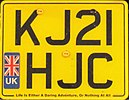
|
|||
| H | ||||
| D | 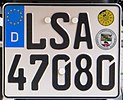
|
|||
| GR | 
|
|||
| GE | ||||
| DK | ||||
| IS | ||||
| IRL | 
|
|||
| E | 
|
|||
| I |  |

|
||
| CY | 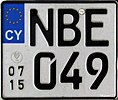
|
|||
| LV | 
|
|||
| LT | 
|
|||
| FL | 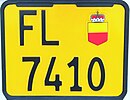
|
|||
| L | 
|
|||
| M | 
|
|||
| MD |  |

|
||
| MC |  |

|
||
| NL | ||||
| N | 
|
|||
| PL | 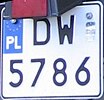
|
|||
| P | ||||
| RUS | ||||
| RO | ||||
| RSM | 
|
|||
| MK, NMK | 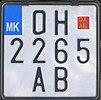
|
|||
| SRB | 
|
|||
| SK | ||||
| SLO | 
|
|||
| TR | 
|
|||
| UA | 
|
|||
| FIN | 
|
|||
| F | 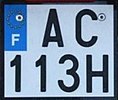
|
|||
| HR | 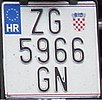
|
|||
| MNE | 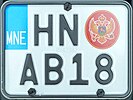
|
|||
| CZ | ||||
| CH | 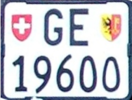
|
|||
| S |  |

|
||
| EST | 
|
- Notes
- ↑ Международный регистрационный код транспортного средства для Соединенного Королевства — UK. До 28 сентября 2021 года это был GB.[4][5]
- ↑ С февраля 2019 код MK заменён на NMK.[6]
Зависимые и спорные территории[править | править код]
| Территория | Код | Европоле | Образец автономера | Образец мотоциклетного номера |
|---|---|---|---|---|
| ABH | ||||
| AX |  |
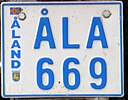
|
||
| GBG | ||||
| GBZ |  |
|||
| GBJ | ||||
| DPR | 
|
|||
| LPR | 
|
|||
| RKS | ||||
| GBM |  |
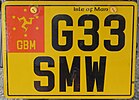
|
||
| PMR | 
|
|||
| NC или KKTCB | ||||
| FO |  |
|||
| RSO | 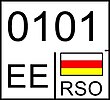
|
Шаблон[править | править код]
Для статей о номерах стран Европы рекомендуется использовать шаблон {{Автомобильные номера Европы}}
Примечания[править | править код]
- ↑ https://eur-lex.europa.eu/legal-content/EN/ALL/?uri=CELEX:31998R2411
- ↑ http://www.irishstatutebook.ie/eli/1990/si/287/made/en/print
- ↑ http://www.worldlicenseplates.com/world/EU_PORT.html
- ↑ GB code when travelling abroad. matriculasdelmundo.com. Matriculasdelmundo. Дата обращения: 3 мая 2021.
- ↑ Convention on Road Traffic Vienna, 8 November 1968: UNITED KINGDOM OF GREAT BRITAIN AND NORTHERN IRELAND: NOTIFICATION UNDER ARTICLE 45 (4).
- ↑ Announcement of the Inter-ministerial working group for fulfilment of the obligations stipulated in the Final Agreement for the Settlement of the Differences as Described in the United Nations Security Council Resolutions 817 (1993) and 845 (1993) (англ.). Government of the Republic of Macedonia (13 February 2019). Дата обращения: 13 февраля 2019.
From Wikipedia, the free encyclopedia
The country in which a motor vehicle’s vehicle registration plate was issued may be indicated by an international licence plate country code, formerly known as an International Registration Letter[1] or International Circulation Mark.[2] It is referred to as the Distinguishing sign of the State of registration in the Geneva Convention on Road Traffic of 1949 and the Vienna Convention on Road Traffic of 1968.
The allocation of codes is maintained by[citation needed] the United Nations Economic Commission for Europe as the Distinguishing Signs Used on Vehicles in International Traffic[3] (sometimes abbreviated to DSIT), authorised by the UN’s Geneva Convention on Road Traffic[4] and the Vienna Convention on Road Traffic.[5] Many vehicle codes created since the adoption of ISO 3166 coincide with ISO two- or three-letter codes. The 2004 South-East Asian Agreement … for the Facilitation of Cross-Border Transport of Goods and People uses a mixture of ISO and DSIT codes: Myanmar uses MYA, China CHN, and Cambodia KH (ISO codes), Thailand uses T (DSIT code), Laos LAO, and Vietnam VN (coincident ISO and DSIT codes).[6]
The Geneva Convention on Road Traffic entered into force on 26 March 1952. One of the main benefits of the convention for motorists is the obligation on signatory countries to recognize the legality of vehicles from other signatory countries. When driving in other signatory countries, the distinguishing sign of the country of registration must be displayed on the rear of the vehicle. This sign must be placed separately from the registration plate and may not be incorporated into the vehicle registration plate.
History[edit]
1909 Paris Convention[edit]
The display of a national distinctive mark on a white oval plate, 30 cm × 18 cm (12 in × 7 in) with black letters was first introduced by the 1909 International Convention with respect to the Circulation of Motor Vehicles signed in Paris. The plate was required to be affixed to the rear of the vehicle, separate from the number plate displaying the vehicle’s national registration mark. The 1909 convention only allowed distinctive marks to be of one or two Latin letters.[7]
| State | Mark |
|---|---|
| D | |
| A | |
| B | |
| E | |
| US | |
| F | |
| GB | |
| GR | |
| H | |
| I | |
| MN | |
| MC | |
| NL | |
| P | |
| R | |
| RO | |
| SB | |
| S | |
| CH | |
| BG |
1924 Paris Convention[edit]
The term distinguishing mark was adopted by the 1924 International Convention Relative to Motor Traffic signed in Paris, which extended the maximum length of mark from two to three Latin letters, and permitted not just distinguishing marks for states, but also for non-sovereign territories which operated their own vehicle registration systems.[8]
| State or territory | Mark | Notes |
|---|---|---|
| D[a] | For the original German name Deutschland | |
| US[a] | ||
| A[a] | ||
| B[a] | ||
| BR | ||
| GB[a] | ||
| Alderney | GBA | |
| GBZ | ||
| Guernsey | GBG | |
| GBJ | ||
| GBY | ||
| BI | ||
| BG[a] | ||
| RCH | ||
| RC | ||
| CO | ||
| C | ||
| DK | ||
| DA | ||
| ET | ||
| EQ | ||
| E[a] | España | |
| EST | ||
| SF | From Finnish Suomi, Swedish Finland. | |
| F[a] | ||
| F | ||
| G | ||
| GR[a] | ||
| RH | ||
| H[a] | ||
| SE | Part of the United Kingdom at the time of the 1909 convention. Initials stand for Irish Saorstát Éireann. | |
| I[a] | ||
| LV | ||
| FL | ||
| LT | ||
| L | ||
| F | ||
| MEX | ||
| MC[a] | ||
| PY | current code is PA | |
| PA | current code is PY | |
| NL[a] | ||
| IN | ||
| PE | ||
| PR | ||
| PL | ||
| P[a] | ||
| R[a] | ||
| SA | League of Nations mandate | |
| SHS | ||
| SM | ||
| S[a] | ||
| CH[a] | ||
| Syria and Lebanon | LSA | French League of Nations mandate |
| CS | ||
| TR | ||
| SU | Russia had been a party to the 1909 convention. | |
| U |
- ^ a b c d e f g h i j k l m n o p q Originally in 1909 convention
Location[edit]
Since the Vienna Convention on Road Traffic entered into force on 21 May 1977, in signatory countries it replaces previous road traffic conventions, including the Geneva Convention on Road Traffic, in accordance with its Article 48. According to the Vienna Convention on Road Traffic, the distinguishing sign of the country of registration must be displayed on the rear of the vehicle. The sign may either be placed separately from the registration plate as a white oval plate or sticker, or be incorporated in the vehicle registration plate. When the distinguishing sign is incorporated in the registration plate, it must also appear on the front registration plate of the vehicle.
The requirement to display a separate distinguishing sign is not necessary within the European Economic Area, for vehicles with license plates in the common EU format, which satisfy the requirements of the Vienna Convention, and so are also valid in non-EU countries signatory to that convention.[9] Separate signs are also not needed for Canada, Mexico and the United States, where the province, state or district of registration is usually embossed or surface-printed on the vehicle registration plate.[citation needed]
Current codes[edit]
| Code | Country | From | Previous code(s) |
Notes |
|---|---|---|---|---|
| A | 1911 | Austria in English or Autriche in French | ||
| AFG | 1971 | Coincides with ISO 3166-1 alpha-3 code. | ||
| AL | 1934 | Coincides with ISO 3166-1 alpha-2 code. | ||
| AND | 1957 | Coincides with ISO 3166-1 alpha-3 code. | ||
| AM | 1992 | SU | Formerly part of the Soviet Union. Coincides with ISO 3166-1 alpha-2 code. | |
| AUS | 1954 | Coincides with ISO 3166-1 alpha-3 code. | ||
| AZ | 1993 | SU | Formerly part of the Soviet Union. Coincides with ISO 3166-1 alpha-2 code. | |
| B | 1910 | |||
| BD | 1978 | PAK | Formerly East Pakistan | |
| BDS | 1956 | |||
| BF | 1990 | RHV / HV | Until August 2003, 1984; (République de) Haute Volta (Upper Volta) | |
| BG | 1910 | Coincides with ISO 3166-1 alpha-2 code. | ||
| BH | 1938 | Formerly British Honduras. Still officially registered as BH as of 2007. New driving licenses appear to have ‘BZ’ instead of ‘BH’ as Belize’s code.[10] | ||
| BIH | 1992 | SHS 1919–29 Y 1929–53 YU 1953–92 |
Bosna i Hercegovina / Босна и Херцеговина (Bosnian). Formerly part of the Kingdom of Serbs, Croats and Slovenes Kraljevina Srba, Hrvata i Slovenaca (Serbo-Croatian), then part of Yugoslavia. Coincides with ISO 3166-1 alpha-3 code. |
|
| BOL | 1967 | Coincides with ISO 3166-1 alpha-3 code. | ||
| BR | 1930 | Coincides with ISO 3166-1 alpha-2 code. | ||
| BRN | 1954 | |||
| BRU | 1956 | |||
| BS | 1950 | |||
| BUR[citation needed] | 1956 | BA, BUR | Previously known as Burma. Coincides with the former ISO 3166-1 alpha-2 code. | |
| BVI | 1910 | |||
| BW[3] | 2003 | BP | Officially used by Botswana since 2003. Formerly RB (Republic of Botswana) until 2004; Bechuanaland Protectorate before 1966. | |
| BY | 1992 (2004) | SU | Belarus; formerly part of the Soviet Union. The UN was officially notified of the change from SU to BY only in 2004.[citation needed] Coincides with ISO 3166-1 alpha-2 code. | |
| CAM | 1952 | F & WAN | Formerly a territory of France, plus a strip of territory from eastern Nigeria (WAN). Unofficially using CMR on their plates. | |
| CDN | 1956 | CA | CDN for «Canada Dominion»[citation needed] | |
| CGO | 1997 | CB, RCL, ZRE | French: Congo Belge, République de Congo Léopoldville, Congo (Kinshasa), Zaïre, République Démocratique du Congo (French) | |
| CH | 1911 | Confœderatio Helvetica (Latin). Coincides with ISO 3166-1 alpha-2 code. | ||
| CI | 1961 | F | Formerly a territory of France. Coincides with ISO 3166-1 alpha-2 code. | |
| CL | 1961 | Formerly Ceylon. However, «SL» is being used on current driver licenses. | ||
| CO | 1952 | Coincides with ISO 3166-1 alpha-2 code. | ||
| CR | 1956 | Coincides with ISO 3166-1 alpha-2 code. | ||
| CU[3] | 1930[citation needed] | Coincides with ISO 3166-1 alpha-2 code. | ||
| CY | 1932 | Coincides with ISO 3166-1 alpha-2 code. | ||
| CZ | 1993 | CS | Formerly Československo (Czechoslovakia). Coincides with ISO 3166-1 alpha-2 code. | |
| D | 1910 | Deutschland (German); also used until 1974 by |
||
| DK | 1914 | Coincides with ISO 3166-1 alpha-2 code. | ||
| DOM | 1952 | Coincides with ISO 3166-1 alpha-3 code. | ||
| DY | 1910 | Part of AOF (Afrique occidentale française) − 1960 |
Dahomey (name until 1975). Uses RB unofficially (République du Bénin) | |
| DZ | 1962 | F − 1911 | Djazayer (Algerian Arabic: جزائر); formerly part of France. Coincides with ISO 3166-1 alpha-2 code. | |
| E | 1910 | España (Spanish) | ||
| EAK | 1938 | East Africa Kenya | ||
| EAT | 1938 | EAT & EAZ | East Africa Tanzania; formerly East Africa Tanganyika and East Africa Zanzibar | |
| EAU | 1938 | East Africa Uganda | ||
| EAZ | 1964 | East Africa Zanzibar | ||
| EC | 1962 | EQ | Coincides with ISO 3166-1 alpha-2 code. | |
| ER | 1993 | AOI | Africa Orientale Italiana (Italian). Coincides with ISO 3166-1 alpha-2 code. | |
| ES | 1978 | |||
| EST | 1993 | EW 1919–1940 & 1991–1993 SU 1940–1991 |
Eesti Vabariik (Estonian; old style Eesti Wabariik). Coincides with ISO 3166-1 alpha-3 code. | |
| ET | 1927 | |||
| ETH | 1964 | AOI − 1941 | Africa Orientale Italiana (Italian). Coincides with ISO 3166-1 alpha-3 code. | |
| F | 1910 | |||
| FIN | 1993 | SF | Suomi / Finland (Finnish/Swedish). Coincides with ISO 3166-1 alpha-3 code. | |
| FJI | 1971 | Coincides with ISO 3166-1 alpha-3 code. | ||
| FL | 1923 | Fürstentum Liechtenstein (German: ‘Principality of Liechtenstein’) | ||
| FO | 1996 | FR | Føroyar. Coincides with ISO 3166-1 alpha-2 code. | |
| G | 1974 | ALEF − 1960 | Afrique Équatoriale Française. Unofficially using RG on their license plates. | |
| GBA | 1924 | GB 1923-1924 | (United Kingdom of) Great Britain & Northern Ireland – Alderney | |
| GBG | 1924 | GB 1914-1924 | (United Kingdom of) Great Britain & Northern Ireland – Guernsey | |
| GBJ | 1924 | GB 1914-1924 | (United Kingdom of) Great Britain & Northern Ireland – Jersey | |
| GBM | 1932 | (United Kingdom of) Great Britain & Northern Ireland – Isle of Man | ||
| GBZ | 1924 | GB 1911-1924 | (United Kingdom of) Great Britain & Northern Ireland – Gibraltar (Z was assigned because G was already used for Guernsey)[citation needed] | |
| GCA | 1956 | G | Guatemala, Central America | |
| GE | 1992 | SU | Formerly part of the Soviet Union. Older licence plates use «GEO» instead of «GE». Also used by Equatorial-Guinea (Spanish: Guinea Ecuatorial). Coincides with ISO 3166-1 alpha-2 code. | |
| GH | 1959 | WAC − 1957 | West Africa Gold Coast − 1957. Coincides with ISO 3166-1 alpha-2 code. | |
| GR | 1913 | Coincides with ISO 3166-1 alpha-2 code. | ||
| GUY | 1972 | BRG | Formerly British Guiana − 1966. Coincides with ISO 3166-1 alpha-3 code. | |
| H | 1910 | |||
| HKJ | 1966 | JOR | Hashemite Kingdom of Jordan | |
| HN | ?[citation needed] | Unofficial: no other code found for Honduras. Coincides with ISO 3166-1 alpha-2 code. | ||
| HR | 1992 | SHS 1919–29 Y 1929–53 YU 1953–92 |
Hrvatska (Croatian). Formerly part of Yugoslavia. Immediately after Croatia’s declaration of independence in 1991, it was common to see unofficial oval stickers with the letters «CRO». Despite the initial anticipation that Croatia’s international vehicle registration code would be «CRO», Croatia opted for «HR» (Hrvatska) instead.
SHS was for the Kingdom of the Serbs, Croats and Slovenes (Kraljevina Srba, Hrvata i Slovenaca). Coincides with ISO 3166-1 alpha-2 code. |
|
| I | 1910 | |||
| IL | 1952 | «Israel» is also written on the plate in Hebrew (ישראל) and Arabic (إسرائيل). Coincides with ISO 3166-1 alpha-2 code. | ||
| IND | 1947 | BI | Coincides with ISO 3166-1 alpha-3 code. | |
| IR | 1936 | PR | Coincides with ISO 3166-1 alpha-2 code. | |
| IRL | 1992 | GB − 1910–24 SE − 1924–38 EIR − 1938–62 EIR/IRL − 1962–92 |
Formerly a part of the United Kingdom, Saorstát Éireann, Éire. Coincides with ISO 3166-1 alpha-3 code. | |
| IRQ | 1930 | Coincides with ISO 3166-1 alpha-3 code. | ||
| IRQ KR | 1991 | Coincides with ISO 3166-1 alpha-2 | ||
| IS | 1936 | Ísland (Icelandic). Coincides with ISO 3166-1 alpha-2 code. | ||
| J | 1964 | |||
| JA | 1932 | |||
| K[citation needed] | 1956 | Known as Kampuchea 1976–89. Formerly a territory of France. KH currently being used (Khmer) on driving licenses, which coincides with ISO 3166-1 alpha-2 code. | ||
| KG | 1992 | SU − 1991 | Formerly part of the Soviet Union. The Kyrgyz government notified the change from «KS» to «KG», which featured on the new car registration plates from March 2016, in August that year to the UN Secretary-General.[11] Additionally, most vehicles use «KGZ» oval stickers instead of «KS». Coincides with ISO 3166-1 alpha-2 code. | |
| KSA | 1973 | SA | Kingdom of Saudi Arabia | |
| KWT | 1954 | |||
| KZ | 1992 | SU − 1991 | Formerly part of the Soviet Union. Coincides with ISO 3166-1 alpha-2 code. | |
| L | 1911 | |||
| LAO | 1959 | F – 1949 | Formerly a territory of France (French Indochina). Coincides with ISO 3166-1 alpha-3 code. | |
| LAR | 1972 | I − 1949, LT | Libyan Arab Republic, unused, unofficial LY used instead. | |
| LB | 1967 | |||
| LS | 1967 | BL | Basutoland − 1966. Coincides with ISO 3166-1 alpha-2 code. | |
| LT | 1992 | SU 1940–1991 | Coincides with ISO 3166-1 alpha-2 code. | |
| LV | 1992 | LR 1927–1940 SU 1940–1991 |
Latvijas Republika (Latvian). Coincides with ISO 3166-1 alpha-2 code. | |
| M | 1966 | GBY 1924–66 | ||
| MA | 1924 | Maroc (French). Coincides with ISO 3166-1 alpha-2 code. | ||
| MAL | 1967 | PRK – 1957 FM 1954–57 PTM 1957–67 |
Formerly Perak, then Federated Malay States, then Persekutuan Tanah Melayu (Malay) | |
| MC | 1910 | Coincides with ISO 3166-1 alpha-2 code. | ||
| MD | 1992 | SU − 1991 | Formerly part of the Soviet Union. Coincides with ISO 3166-1 alpha-2 code. | |
| MEX | 1952 | Coincides with ISO 3166-1 alpha-3 code. | ||
| MNE | 2006 | MN 1913–1919 SHS 1919–29 Y 1929–53 YU 1953–2003 SCG 2003–2006 |
Independent nation until 1918. After that, part of the Kingdom of Serbs, Croats and Slovenes (Kraljevina Srba, Hrvata i Slovenaca – Serbo-Croatian), then part of Yugoslavia and then Serbia and Montenegro (Srbija i Crna Gora – Serbian). Independence restored in 2006. Coincides with ISO 3166-1 alpha-3 code. | |
| MGL | 2002 | MNG displayed on current plates. Nevertheless, the new format includes MGL once again.[12] Coincides with ISO 3166-1 alpha-3 code. | ||
| MOC | 1975 | MOC: 1932–56 P: 1957–75 |
Formerly part of Portugal. Moçambique (Portuguese). Coincides with ISO 3166-1 alpha-3 code. | |
| MS | 1938 | |||
| MV | 1965 | Coincides with ISO 3166-1 alpha-2 code. | ||
| MW | 1965 | EA 1932–38 NP – 1938–70 RNY option 1960–65 |
Formerly the Nyasaland Protectorate. Coincides with ISO 3166-1 alpha-2 code. | |
| N | 1922 | |||
| NAM | 1990 | SWA | Formerly South West Africa. Coincides with ISO 3166-1 alpha-3 code. | |
| NAU | 1968 | |||
| NEP | 1970 | |||
| NIC | 1952 | Coincides with ISO 3166-1 alpha-3 code. | ||
| NL | 1910 | Coincides with ISO 3166-1 alpha-2 code. | ||
| NMK | 2019 | YU − 1992 MK 1992–2019 |
Formerly part of Yugoslavia. Known as Republic of Macedonia until 2019. Mix of English North and Macedonian Makedonija. | |
| NZ | 1958 | Coincides with ISO 3166-1 alpha-2 code. | ||
| OM | ?[citation needed] | Coincides with ISO 3166-1 alpha-2 code. | ||
| P | 1910 | Unofficially used for Palestine in the West Bank and Gaza Strip.[13] | ||
| PA | 1952 | PY 1924–1952 | Coincides with ISO 3166-1 alpha-2 code. | |
| PE | 1937 | Coincides with ISO 3166-1 alpha-2 code. | ||
| PK | 1947 | Coincides with ISO 3166-1 alpha-2 code. | ||
| PL | 1921 | Coincides with ISO 3166-1 alpha-2 code. | ||
| PNG | 1978 | Coincides with ISO 3166-1 alpha-3 code. | ||
| PY | 1952 | PA 1924–1952 | Coincides with ISO 3166-1 alpha-2 code. | |
| Q | 1972 | |||
| RA | 1927 | República Argentina (Spanish) | ||
| RC | 1932 | Unofficially also used by car license plates in the Republic of Congo (République du Congo). | ||
| RCA | 1962 | République Centrafricaine (French) | ||
| RCB | 1962 | République du Congo Brazzaville (French). Unofficially using RC on current plates. | ||
| RCH | 1930 | República de Chile (Spanish) | ||
| RG | 1972 | République de Guinée (French). Also used unofficially by Gabon. | ||
| RH | 1952 | République d’Haïti (French) | ||
| RI | 1955 | Republik Indonesia (Indonesian) | ||
| RIM | 1964 | République islamique de Mauritanie (French) | ||
| RKS | 2010 | SHS 1919–29 Y 1929–53 YU 1953–2003 SCG 2003–2006 SRB 2006–2010 |
Republic of Kosovo | |
| RL | 1952 | République Libanaise (French) | ||
| RM | 1962 | République de Madagascar (French) | ||
| RMM | 1962 | AOF − 1960 | République du Mali (French). Formerly part of French West Africa (Afrique Occidentale Française) | |
| RN | 1977 | AOF − 1960 | République du Niger (French). Formerly part of French West Africa (Afrique Occidentale Française) | |
| RO | 1981 | R — 1981 | Coincides with ISO 3166-1 alpha-2 code. | |
| ROK | 1971 | Republic of Korea. Unofficially using KOR on their plates. | ||
| RP | 1975 | Republika ng Pilipinas (Republic of the Philippines) | ||
| RSM | 1932 | Repubblica di San Marino (Italian) | ||
| RU | 1960 | Belgian territory of Ruanda-Urundi. Unofficially using BU on their plates. | ||
| RUS | 1992 | Formerly part of the Soviet Union. Coincides with ISO 3166-1 alpha-3 code. | ||
| RWA | 1964 | RU − 1962 | Formerly part of Ruanda-Urundi − 1962. Coincides with ISO 3166-1 alpha-3 code. | |
| S | 1911 | |||
| SD | 1935 | Formerly Swaziland | ||
| SGP | 1952 | Coincides with ISO 3166-1 alpha-3 code. | ||
| SK | 1993 | CS 1919–39,1945–92 SQ 1939–45 |
Formerly Československo (Czechoslovakia). Coincides with ISO 3166-1 alpha-2 code. | |
| SLO[14] | 1992 | SHS 1919–29 Y 1929–53 YU 1953–92 |
Formerly part of the Kingdom of Serbs, Croats and Slovenes Kraljevina Srba, Hrvata i Slovenaca (Serbo-Croatian), then part of Yugoslavia. | |
| SME | 1936 | |||
| SN | 1962 | Coincides with ISO 3166-1 alpha-2 code. | ||
| SO | 1974 | SP | Formerly Somaliland Protectorate. Coincides with ISO 3166-1 alpha-2 code. | |
| SRB | 2006 | SB – 1919 SHS 1919–29 Y 1929–53 YU 1953–2003 SCG 2003–2006 |
Formerly part of the Kingdom of Serbia. Then part of Kingdom of Serbs, Croats and Slovenes (Kraljevina Srba, Hrvata i Slovenaca – Serbo-Croatian). Then part of Yugoslavia. Then Serbia and Montenegro (Srbija i Crna Gora – Serbian). Coincides with ISO 3166-1 alpha-3 code. |
|
| SUD | 1963 | |||
| SY | 1938 | |||
| SYR | 1952 | Coincides with ISO 3166-1 alpha-3 code. | ||
| T | 1955 | SM | ||
| TCH | 1973 | Tchad (French) | ||
| TG | 1973 | RT | Formerly République Togolaise (French). Coincides with ISO 3166-1 alpha-2 code. | |
| TJ | 1992 | SU − 1991 | Formerly part of the Soviet Union, used code «PT» for Республика Таджикистан
on plates from 1993 to 2003. Coincides with ISO 3166-1 alpha-2 code. |
|
| TM | 1992 | SU − 1991 | Formerly part of the Soviet Union. Coincides with ISO 3166-1 alpha-2 code. | |
| TN | 1957 | F − 1956 | Formerly a territory of France. Coincides with ISO 3166-1 alpha-2 code. Unoffical code TU is common. | |
| TO | 1995 | Coincides with ISO 3166-1 alpha-2 code. | ||
| TR | 1923 | Coincides with ISO 3166-1 alpha-2 code. | ||
| TT | 1964 | Coincides with ISO 3166-1 alpha-2 code. | ||
| UA | 1992 | SU | Formerly part of the Soviet Union. Coincides with ISO 3166-1 alpha-2 code. | |
| UAE | 1971 | |||
| UK | 2021 | GB (1910–2021) | Before 1922, United Kingdom of Great Britain and Ireland. Until 2021, «GB» was used, but from 28 September 2021 the United Kingdom of Great Britain and Northern Ireland changed its international vehicle registration code from «GB» to «UK». (This does not affect territories for which the United Kingdom controls international relations outside Great Britain and Northern Ireland.)[15][16] | |
| USA | 1952 | US | Coincides with ISO 3166-1 alpha-3 code. | |
| UY[citation needed] | 2012 | ROU | Coincides with ISO 3166-1 alpha-2 code. | |
| UZ | 1992 | SU | Formerly part of the Soviet Union. Coincides with ISO 3166-1 alpha-2 code. | |
| V | 1931 | CV (Italian: Città del Vaticano) is used as a prefix on the licence plate number itself. The prefix used on official and government vehicles is SCV (Latin: Status Civitatis Vaticanae) | ||
| VN | 1953 | Coincides with ISO 3166-1 alpha-2 code. | ||
| WAG | 1932 | West Africa Gambia | ||
| WAL | 1937 | West Africa Sierra Leone; on local licence plates SLE is used | ||
| WAN | 1937 | West Africa Nigeria | ||
| WD | 1954 | Windward Islands Dominica | ||
| WG | 1932 | Windward Islands Grenada | ||
| WL | 1932 | Windward Islands Saint Lucia | ||
| WS | 1962 | Formerly Western Samoa. Coincides with ISO 3166-1 alpha-2 code. | ||
| WV | 1932 | Windward Islands Saint Vincent | ||
| YAR | 1960 | North Yemen formerly known as the Yemen Arab Republic. | ||
| YV | 1955 | |||
| Z | 1964[citation needed] | RNR | Formerly Northern Rhodesia. However, «ZM» is used on current driving licences. | |
| ZA | 1936 | Zuid-Afrika (from Dutch; in Afrikaans it is Suid-Afrika). Coincides with ISO 3166-1 alpha-2 code. | ||
| ZW | 1980 | SR, RSR | Formerly Southern Rhodesia until 1965, Rhodesia unrecognised until 1980. Coincides with ISO 3166-1 alpha-2 code. |
Codes no longer in use[edit]
| Code | Country | Used until | Replaced by | Notes |
|---|---|---|---|---|
| ADN | 1980 | Y | From 1938, also known as South Yemen, People’s Democratic Republic of Yemen (1967) | |
| BA | 1956 | BUR | From 1937 | |
| BP | 1966 | Now Botswana | ||
| CA | 1956 | CDN | ||
| CS | 1992 | CZ / SK | Split into Czech Republic and Slovakia. Coincided with ISO 3166-1 alpha-2 code. | |
| DA | 1939 | D (1939–1945) PL (since 1945) |
Danzig (German for Gdańsk) | |
| DDR | 1990 | D | From 1974 (used D until 1974), Deutsche Demokratische Republik. Coincided with ISO 3166-1 alpha-3 code. | |
| EIR | 1992 | IRL | Now |
|
| EW | 1993 | EST | Eesti Vabariik (Estonian) | |
| FR | 1996 | FO | Føroyar (Faroese) | |
| GB | 2021 | UK | Changed to UK to be inclusive of Northern Ireland (which is not part of Great Britain), though the previous GB did also apply to Northern Ireland. Coincided with ISO 3166-1 alpha-2 code. | |
| GBY | 1966 | M | Changed after independence from UK | |
| GRO | 1910 | KN | Grønland (Danish language) / Kalaallit Nunaat (Greenlandic language). Unofficial. The official code is DK. | |
| HV | 1984 | BF | Upper Volta. Coincided with ISO 3166-1 alpha-2 code. | |
| KS | 1992–2016 | KG | Ratified by the United Nations as KG in March 2016. | |
| LR | 1927–1940 | SU, LV | Latvijas Republika (Latvian) | |
| MK | 1992–2019 | NMK | Became North Macedonia in 2019. Coincided with ISO 3166-1 alpha-2 code. | |
| NA | 1957 | The Netherlands Antilles were dissolved in 2010. | ||
| PANG | 1956 | P (1957-1975) | From 1932. Formerly part of Portugal | |
| R | 1981 | RO | ||
| RNY | 1953–1963 | NP, NR, SR | Now Malawi, Zambia and Zimbabwe | |
| ROU | 1979–2012 | UY[citation needed] | República Oriental del Uruguay (Spanish) | |
| RSR | 1965–1979 | SR | Now Zimbabwe | |
| RT | 1973 | TG | République togolaise (French). Formerly French Togoland − 1960 | |
| SA | 1926–1935 | D | SA is again Germany’s Saarland | |
| SA | 1947–1956 | D | SA is again Germany’s Saarland | |
| SA | Unknown | KSA | The date of the change is unknown. Coincided with ISO 3166-1 alpha-2 code. | |
| SB | 1919 | SHS | Serbia became part of Kingdom of Serbs, Croats and Slovenes | |
| SCG | 2006 | MNE, SRB | From Serbian name «Srbija i Crna Gora». Now Montenegro, Serbia. Coincided with ISO 3166-1 alpha-3 code. | |
| SE | 1938 | EIR (IRL from 1962) | Under GB until 1924. Name changed to Éire, now |
|
| SF | 1993 | FIN | SF from «Suomi – Finland» (the names of the country in its official languages, Finnish and Swedish) | |
| SHS | 1929 | Y | Kraljevina Srba, Hrvata i Slovenaca – Serbo-Croatian. Kingdom changed its name to Yugoslavia | |
| SU | 1991 | EST, LT, LV, BY, MD, UA, TJ, TM, GE, KZ, UZ, KS, AZ, AM, RUS | Coincided with ISO 3166-1 alpha-2 code. | |
| SWA | 1990 | Now Namibia | ||
| TS | 1947–1954 | Territory Zone A (controlled by the United Kingdom and United States from 1947 to 1954 before given to Italy). Now in Italy, Croatia and Slovenia. | ||
| Y | 1953 | YU | Yemen started using Y afterwards | |
| YU | 1992 | BIH, HR, NMK, MNE, RKS, SRB, SLO | Now Bosnia and Herzegovina, Croatia, North Macedonia, Montenegro, Kosovo, Serbia, and Slovenia. MK for Macedonia was in use from 1993 until 2019. Coincided with ISO 3166-1 alpha-2 code. | |
| ZRE | 1997 | CGO | Now the Democratic Republic of the Congo |
Unofficial codes[edit]
There are unofficial codes in common use, such as «AS» for Asturias, «CAT» for Catalonia, «SCO» for Scotland, «CYM» for Wales (Welsh Cymru), «BZH» for Brittany (Breizh), FRL for Friesland, «VL» for Flanders (Vlaanderen), «V» for Vojvodina/Vajdaság, «TS» for Transylvania, «P» for Palestine, «PR» for Puerto Rico, «CSB» for Kashubia (Cassubia) and «SIC» for Székely Land (from Latin Terra Siculorum). Some of these, such as «VL» which is used by Flemish separatists, are used despite being specifically illegal under local laws.
In addition, in some areas, vehicle-style stickers have been used to denote and promote other entities, such as towns, islands, businesses, and even associations. These irregular stickers almost always bear an explanation of the code in small print near the edge of the sticker, as the codes used may be unfamiliar.
Diplomatic licence plate codes[edit]
A separate system is used for vehicles belonging to the diplomats of foreign countries with license plates from the host country. That system is host country-specific and varies largely from country to country. For example, TR on a diplomatic car in the USA indicates Italian, not Turkish. Such markings in other countries (e.g. Norway) are indicated with numbers only, again different from international standards (e.g. 90 means Slovakia in Norway).
See also[edit]
- Aircraft registration
- International Driving Permit
- ISO 3166
- Vienna Convention on Road Traffic
- Vehicle identification number
References[edit]
- ^ Georgano, G. N.; Andersen, Thorkil Ry (1982). The New encyclopedia of motorcars, 1885 to the present. p. 18. ISBN 0-525-93254-2.
- ^ Harding, Anthony; Bird, Anthony (1980). Guinness Book of Car Facts and Feats: A Record of Everyday Motoring and Automotive Achievements. p. 243. ISBN 0-85112-207-8.
- ^ a b c «Distinguishing Signs used on Vehicles in International Traffic» (PDF). United Nations Economic Commission for Europe.
- ^ «Convention of Road Traffic signed at Geneva September, 19 1949 – Annex 4. Distinguishing Sign of Vehicles in International Traffic». Auto Driver Club. NYS ZONE INC. Retrieved 2016-11-24.
- ^ «Convention on Road Traffic on 8 November 1968 – Index Page». Auto Driver Club. NYS ZONE INC. Retrieved 2016-11-24.
- ^ «Annex 2: Registration of Vehicles in International Traffic» (PDF). Agreement between and among the Governments of the Kingdom of Cambodia, the People’s Republic of China, the Lao People’s Democratic Republic, the Union of Myanmar, the Kingdom of Thailand, and the Socialist Republic of Vietnam for the Facilitation of Cross-Border Transport of Goods and People. 2004. Archived from the original (PDF) on March 4, 2012.
- ^ «1909 Paris Convention for the International Circulation of Motor Vehicles» (PDF).
- ^ «International Convention Relative to Motor Traffic, Paris, 1924».
- ^ «Council Regulation (EC) No 2411/98». Council of the European Union. 3 November 1998.
- ^ «Driver’s license will have a new look». Love FM. 2019-07-22. Retrieved 2021-12-20.
- ^ «Convention sur la circulation routière, signée à Vienne, le 8 novembre 1968 — Notification en vertu du paragraphe 4 de l’article 45 par le Kirghizistan. — Legilux». legilux.public.lu. Retrieved 2021-10-28.
- ^ «Discussions of Mongolian license plates / Дискуссии по монгольским номерам». 18 June 2009.
- ^ «License Plates of Palestine».
- ^ «Car: International car registration letters Word Lists». Collins English Word Lists.
- ^ Griffiths, Hugo (5 July 2021). «GB stickers no longer valid for driving abroad». autoexpress.co.uk. Retrieved 5 July 2021.
- ^ «Convention on Road Traffic Vienna, 8 November 1968: United Kingdom of Great Britain and Northern Ireland: Notification under Article 45 (4)» (PDF).
Further reading[edit]
- «RPW»: Neil Parker and John Weeks, Registration Plates of the World, Europlate; 4th edition (2004)
External links[edit]
- Distinguishing Signs of Vehicles, UNECE
- Distinguishing Signs used on Vehicles in International Traffic Notified to the Secretary General of the United Nations, UNECE
- Convention on Road Traffic, Geneva, United Nations Treaty Collection
- Convention on Road Traffic, Vienna, United Nations Treaty Collection
- UN Economic Commission for Europe, Working Party on Road Transport (WP.11)
- Miscellaneous Proposals of Amendments to the Model Regulations on the Transport of Dangerous Goods: Identification of Approval Country in Marking, UN/SCETDG/33/INF.5 (table compares ISO 3166 and DSIT codes)
- Association Francoplaque: Collectionneurs de Plaques d’Immatriculation (data mostly from RPW, above)
- European Registration Plate Association: Registration Plates of the World Online (registration required; data mostly from RPW, above)
Европейские автомобильные номера — это не просто буквенно-цифровые коды, а целая история развития автомобилестроения в Европе. Расшифровка номеров поможет определить страну и другие детали о машине. Давайте разберемся во всех тонкостях еврономеров!
История появления единого формата номерных знаков в ЕС
Единый формат европейских автомобильных номеров был введен в 1998 году на основе моделей, которые уже использовались в то время в Германии, Ирландии и Португалии. Этот формат включает в себя несколько обязательных элементов:
- Полоса синего цвета слева
- Круг из 12 желтых звезд — символ Евросоюза
- Двухбуквенный код страны регистрации
Однако не все страны ЕС используют этот формат. Например, Швеция, Финляндия и некоторые другие сохранили свои национальные стандарты номерных знаков.
Основные форматы европейских автомобильных номеров
Несмотря на наличие единого европейского стандарта, существует несколько разновидностей номерных знаков в Европе.
Стандартный формат (520 × 120 мм)
Этот формат используется в большинстве стран ЕС, в частности в Германии, Франции, Италии. Пример немецкого номера:
Другие размеры
В некоторых странах применяются номера нестандартных размеров, например:
- 325 × 120 мм — Испания
- 340 × 110 мм — Португалия
- 280 × 130 мм — Люксембург
Интересный факт: в Италии до сих пор можно встретить автомобили со старыми маленькими номерами размером 325 × 107 мм, которые выдавались до 1994 года!
Отличительные признаки номерных знаков Германии
Номера машин из Германии можно опознать по таким характерным чертам:
- Код страны — D
- Черные буквы и цифры на белом фоне
- Стандартный размер 520 × 120 мм
- Особый шрифт немецких номеров с закругленными углами
Типичный немецкий автомобильный номер:
Отличительные признаки номерных знаков Франции
Французские номера выглядят следующим образом:
- Код страны — F
- Черные знаки на белом фоне
- Стандартный размер таблички
- Департамент регистрации обозначен двумя цифрами (от 01 до 95)
Пример французского автомобильного номера:
Расшифровка кода страны на еврономерах
Код страны на европейских номерных знаках представляет собой буквенное обозначение из одной или двух букв. Рассмотрим значение некоторых двухбуквенных кодов:
| Код | Страна |
| GB | Великобритания |
| D | Германия |
| F | Франция |
| I | Италия |
Также существуют коды и для стран за пределами Евросоюза, например NO для Норвегии.
Интересные факты про еврономера
В некоторых европейских странах действуют необычные правила или традиции в области автомобильных номеров. Расскажем о некоторых курьезах.
Персональные номера в Австрии
В Австрии любой желающий может приобрести понравившееся сочетание букв и цифр для своего автомобиля всего за 245 евро. Однако при этом запрещен целый ряд комбинаций.
«Сквозная» нумерация в Ирландии
В Ирландии автомобили регистрируются по порядку номеров от 1 до 9999, которые присваиваются подряд вне зависимости от региона. Таким образом, рядом могут ездить машины из совершенно разных уголков страны!
Правила въезда в Россию на автомобиле с еврономерами
Для въезда в Россию на машине с европейскими номерами требуется оформление специальных регистрационных знаков. При этом необходимо:
- Обратиться в таможенные органы для оформления временного ввоза транспортного средства
- Предоставить документы, подтверждающие право собственности на автомобиль
- Получить и установить на автомобиль временные регистрационные знаки России
Советы по распознаванию еврономеров
Чтобы научиться без труда определять, из какой страны Европы приехал встречный автомобиль, можно воспользоваться несколькими полезными советами:
- Запомнить двухбуквенные коды наиболее популярных туристических направлений (Испания, Италия, Германия и т.д.)
- Обращать внимание на форму и размер таблички, цвет шрифта и фон
- Иметь под рукой справочник кодов стран или пользоваться интернет-ресурсами
Любопытные факты о еврономерах
- В Монако автовладельцы могут выбрать для своей машины номер с указанием имени или фамилии
- На Кипре на регистрационных знаках часто изображают популярные туристические достопримечательности
- В Швейцарии встречаются номера кантонов со старинным готическим шрифтом
Преимущества и недостатки еврономеров
Плюсы:
- Удобство передвижения по ЕС без дополнительных документов
- Возможность сразу идентифицировать страну
- Единый размер и стандарт оформления облегчает распознавание
Минусы:
- Не используется во всех странах ЕС
- Сохранение разных шрифтов и дизайна затрудняет восприятие
- Небольшой размер таблички ограничивает варианты оформления
Тенденции развития европейских автономеров
Несмотря на наличие устоявшихся форматов, европейские номерные знаки продолжают развиваться. Какие тенденции можно отметить:
- Переход на цифровые технологии и виртуальные номера
- Использование экологичных материалов для изготовления
- Внедрение дополнительных защитных элементов от подделок
Цифровизация автономеров
Некоторые страны тестируют цифровые номера, которые отображаются на экранах вместо физических табличек. Это позволит упростить регистрацию и идентификацию автомобилей.
Экологически чистые материалы
Все больше европейских стран переходят на производство регистрационных знаков из переработанных пластиков, что снижает нагрузку на окружающую среду.
Необычный дизайн еврономеров
Некоторые страны экспериментируют с внешним видом автомобильных номеров, внедряя нестандартные дизайнерские решения:
- Яркие цветные графические элементы
- Надписи и символы в стиле граффити
- Изображения достопримечательностей и пейзажей
Однако такие экспериментальные номера пока редко используются на практике.
Еврономера для электромобилей
Во многих европейских странах для электрокаров и гибридов введены особые регистрационные знаки, отличающиеся от обычных номеров:
- Норвегия — зеленый фон таблички
- Нидерланды — синие буквы на желтом фоне
- Португалия — надпись «Eletric»
Это позволяет более четко идентифицировать «зеленый» транспорт на дорогах.
Преимущества специальных номеров
- Возможность использования выделенных полос для электромобилей
- Получение различных льгот, например, освобождение от уплаты дорожных пошлин
- Повышение статуса и имиджа владельца «экологичного» автомобиля
Перспективы введения единого еврономера
В Евросоюзе обсуждается идея ввести для всех стран абсолютно унифицированный стандарт автомобильных номеров. Это имело бы ряд плюсов:
- Упрощение процедуры регистрации транспортных средств
- Облегчение идентификации автомобилей из любой страны ЕС
- Сокращение издержек производителей номерных знаков
Однако пока многие страны сохраняют приверженность национальным стандартам номерных знаков.
Автомобильные коды стран мира и Европы
Автомобильные коды стран требуются для идентификации государства регистрации автомобиля. Ранее для этой цели служила наклейка, на которой код страны указывался заглавными буквами. Наклейка должна крепиться в задней части транспортного средства возле номерного знака.
В последнее время страны переходят на определение принадлежности на регистрационных знаках. Наклейка в этом случае уже не требуется.
Тем не менее, были случаи (например, в Германии), когда за её отсутствие выписывали штраф. Во избежание недоразумений, даже если не хотите её приклеивать, лучше возить наклейку с собой и приклеить по первому требованию.
Согласно Конвенции о международном движении наклейка должна быть выполнена в виде эллипса, главная ось которого горизонтальна, а буквы должны быть черными на белом фоне.
Так же читайте: Автомобильные коды всех городов и регионов России
Автомобильные коды Европы |
||||||||||||||||||||||||||||||||||||||||||||||||||||||||||||||||||||||||||||||||||||||||||||||||||||||||||||||||||||||||||||||||||||||||||||||||||||||||||||||||||||||||||||||||||||||||||||||||||||||||||||||||||||||||||||||||||||
* — неофициальный код |
||||||||||||||||||||||||||||||||||||||||||||||||||||||||||||||||||||||||||||||||||||||||||||||||||||||||||||||||||||||||||||||||||||||||||||||||||||||||||||||||||||||||||||||||||||||||||||||||||||||||||||||||||||||||||||||||||||
Автомобильные коды Америки |
||||||||||||||||||||||||||||||||||||||||||||||||||||||||||||||||||||||||||||||||||||||||||||||||||||||||||||||||||||||||||||||||||||||||||||||||||||||||||||||||||||||||||||||||||||||||||||||||||||||||||||||||||||||||||||||||||||
* — неофициальный код |
||||||||||||||||||||||||||||||||||||||||||||||||||||||||||||||||||||||||||||||||||||||||||||||||||||||||||||||||||||||||||||||||||||||||||||||||||||||||||||||||||||||||||||||||||||||||||||||||||||||||||||||||||||||||||||||||||||
Автомобильные коды Азии |
||||||||||||||||||||||||||||||||||||||||||||||||||||||||||||||||||||||||||||||||||||||||||||||||||||||||||||||||||||||||||||||||||||||||||||||||||||||||||||||||||||||||||||||||||||||||||||||||||||||||||||||||||||||||||||||||||||
* — неофициальный код |
||||||||||||||||||||||||||||||||||||||||||||||||||||||||||||||||||||||||||||||||||||||||||||||||||||||||||||||||||||||||||||||||||||||||||||||||||||||||||||||||||||||||||||||||||||||||||||||||||||||||||||||||||||||||||||||||||||
Автомобильные коды Африки |
||||||||||||||||||||||||||||||||||||||||||||||||||||||||||||||||||||||||||||||||||||||||||||||||||||||||||||||||||||||||||||||||||||||||||||||||||||||||||||||||||||||||||||||||||||||||||||||||||||||||||||||||||||||||||||||||||||
* — неофициальный код |
||||||||||||||||||||||||||||||||||||||||||||||||||||||||||||||||||||||||||||||||||||||||||||||||||||||||||||||||||||||||||||||||||||||||||||||||||||||||||||||||||||||||||||||||||||||||||||||||||||||||||||||||||||||||||||||||||||
Автомобильные коды Австралии и Океании |
||||||||||||||||||||||||||||||||||||||||||||||||||||||||||||||||||||||||||||||||||||||||||||||||||||||||||||||||||||||||||||||||||||||||||||||||||||||||||||||||||||||||||||||||||||||||||||||||||||||||||||||||||||||||||||||||||||
* — неофициальный код |
||||||||||||||||||||||||||||||||||||||||||||||||||||||||||||||||||||||||||||||||||||||||||||||||||||||||||||||||||||||||||||||||||||||||||||||||||||||||||||||||||||||||||||||||||||||||||||||||||||||||||||||||||||||||||||||||||||
Устаревшие коды |
||||||||||||||||||||||||||||||||||||||||||||||||||||||||||||||||||||||||||||||||||||||||||||||||||||||||||||||||||||||||||||||||||||||||||||||||||||||||||||||||||||||||||||||||||||||||||||||||||||||||||||||||||||||||||||||||||||
|
* — неофициальный код











